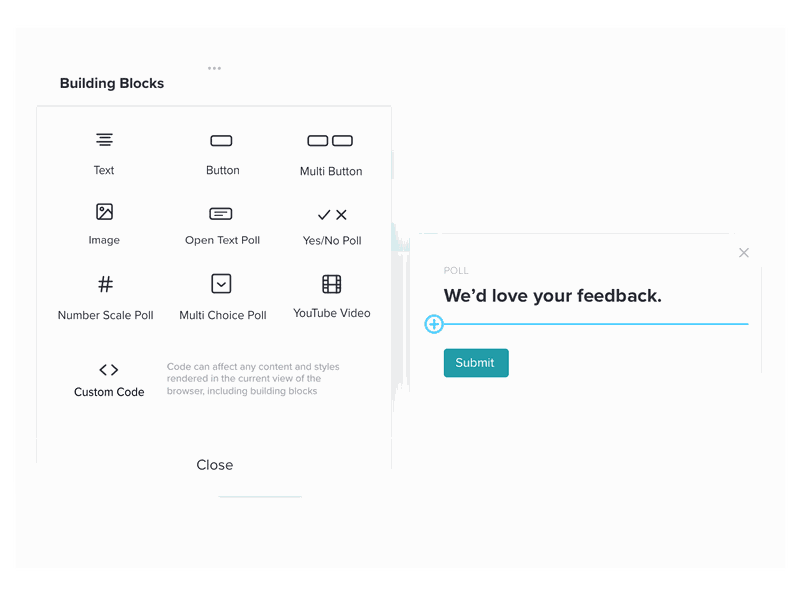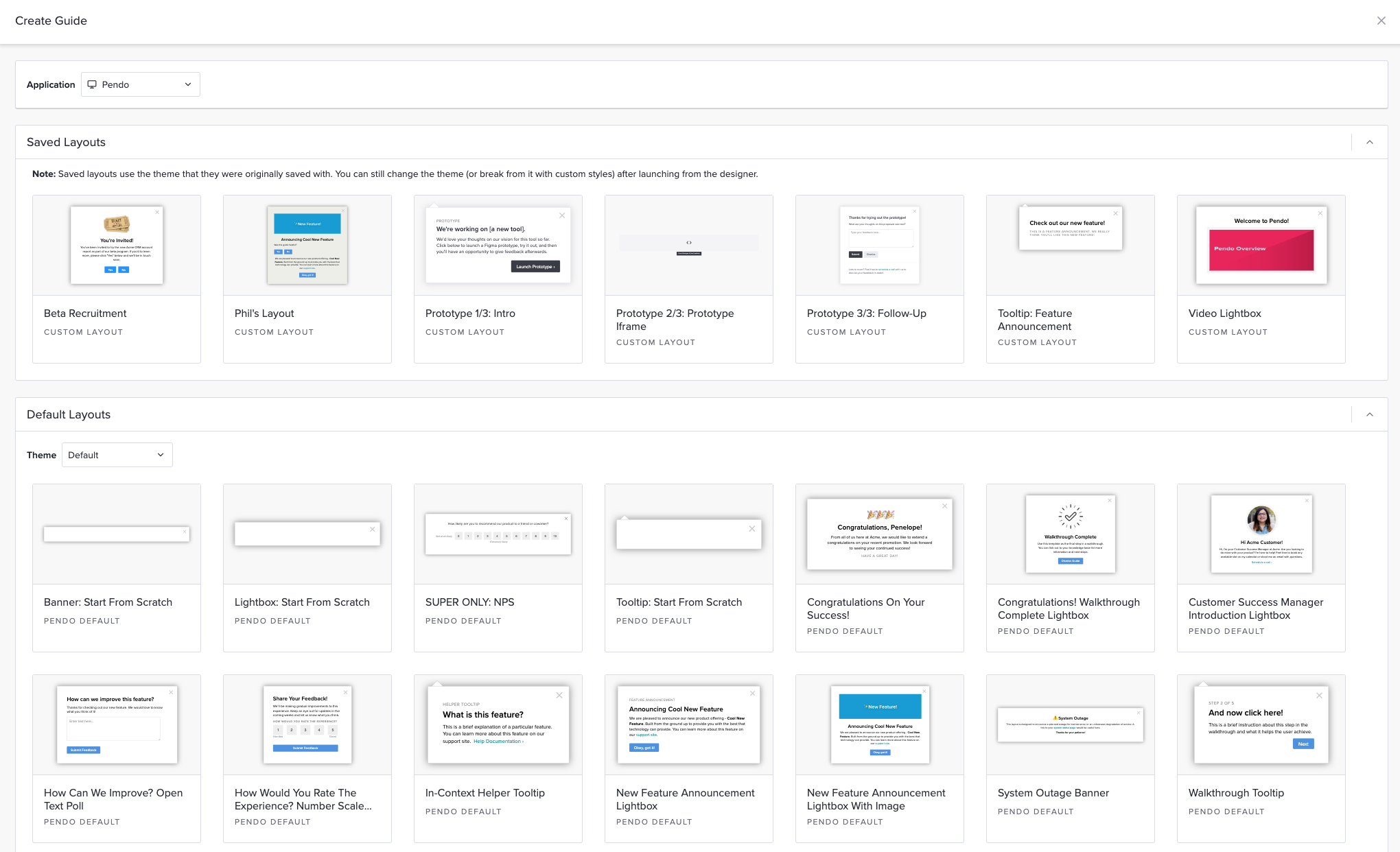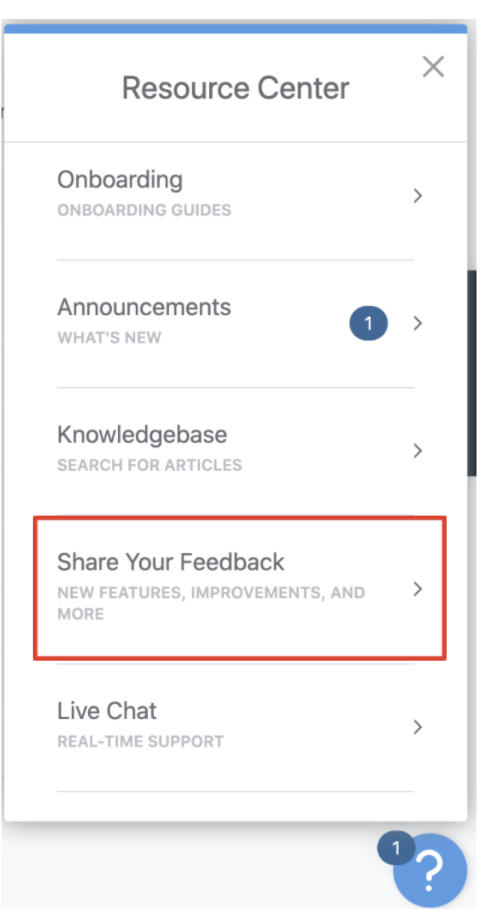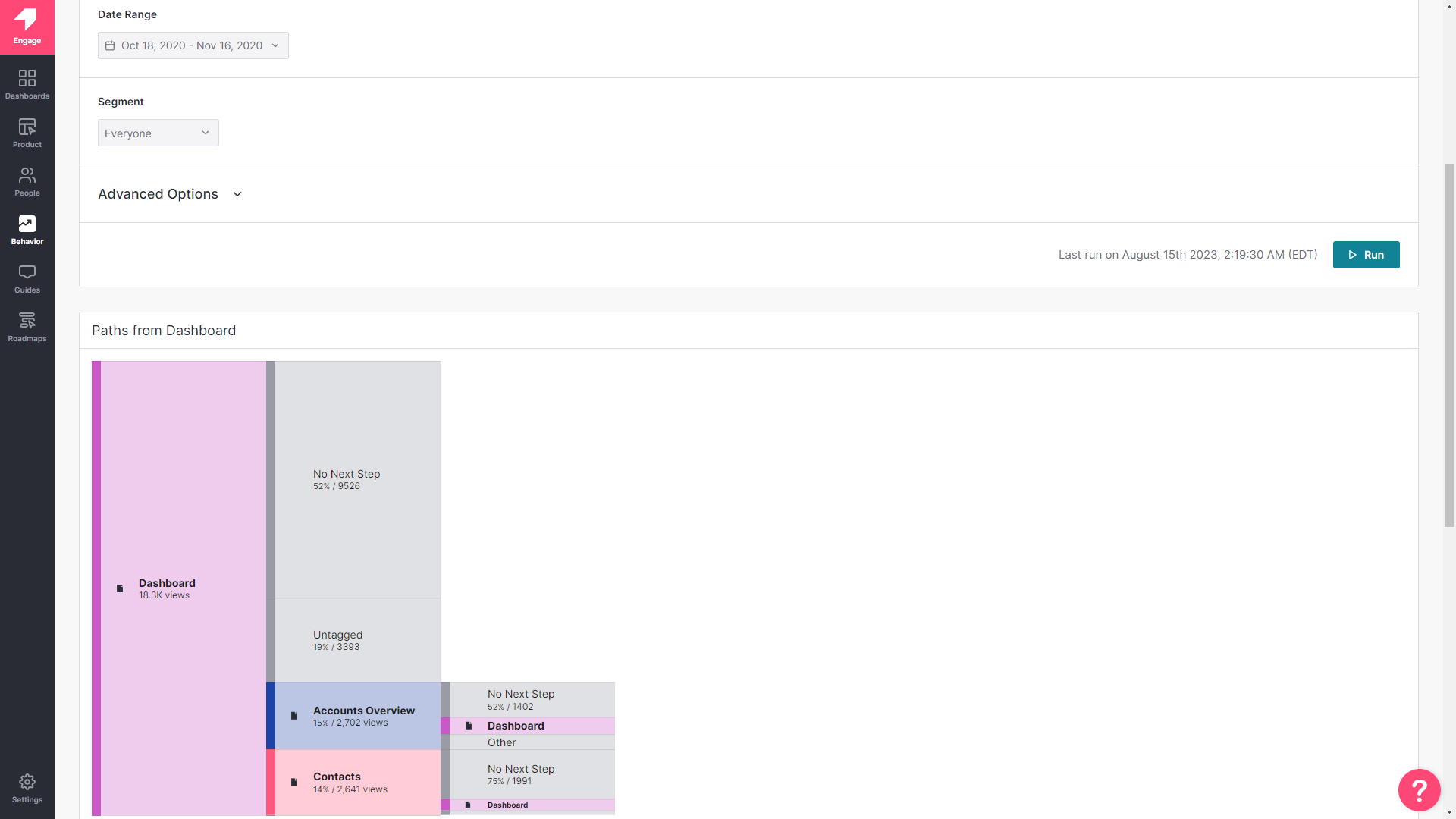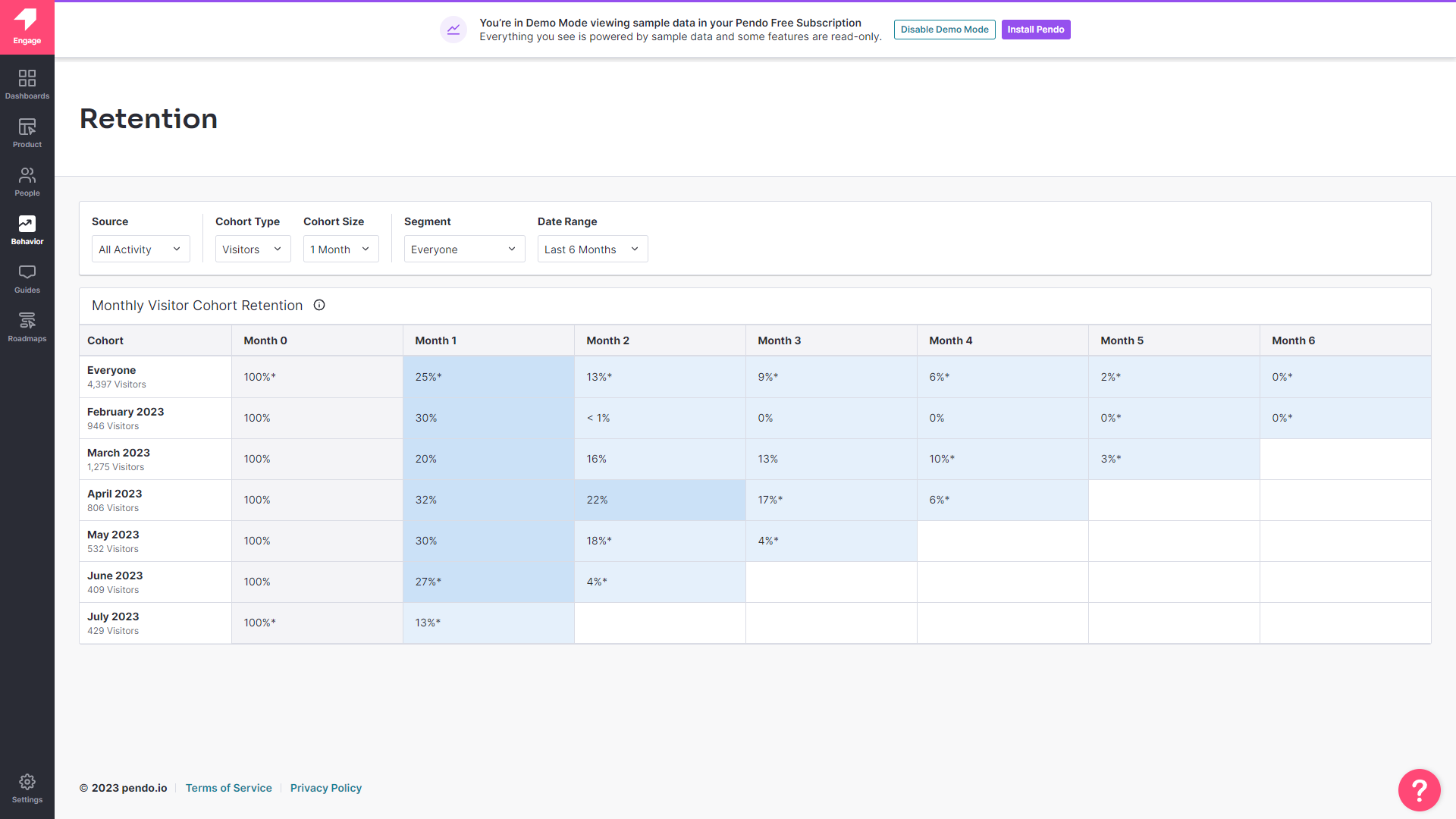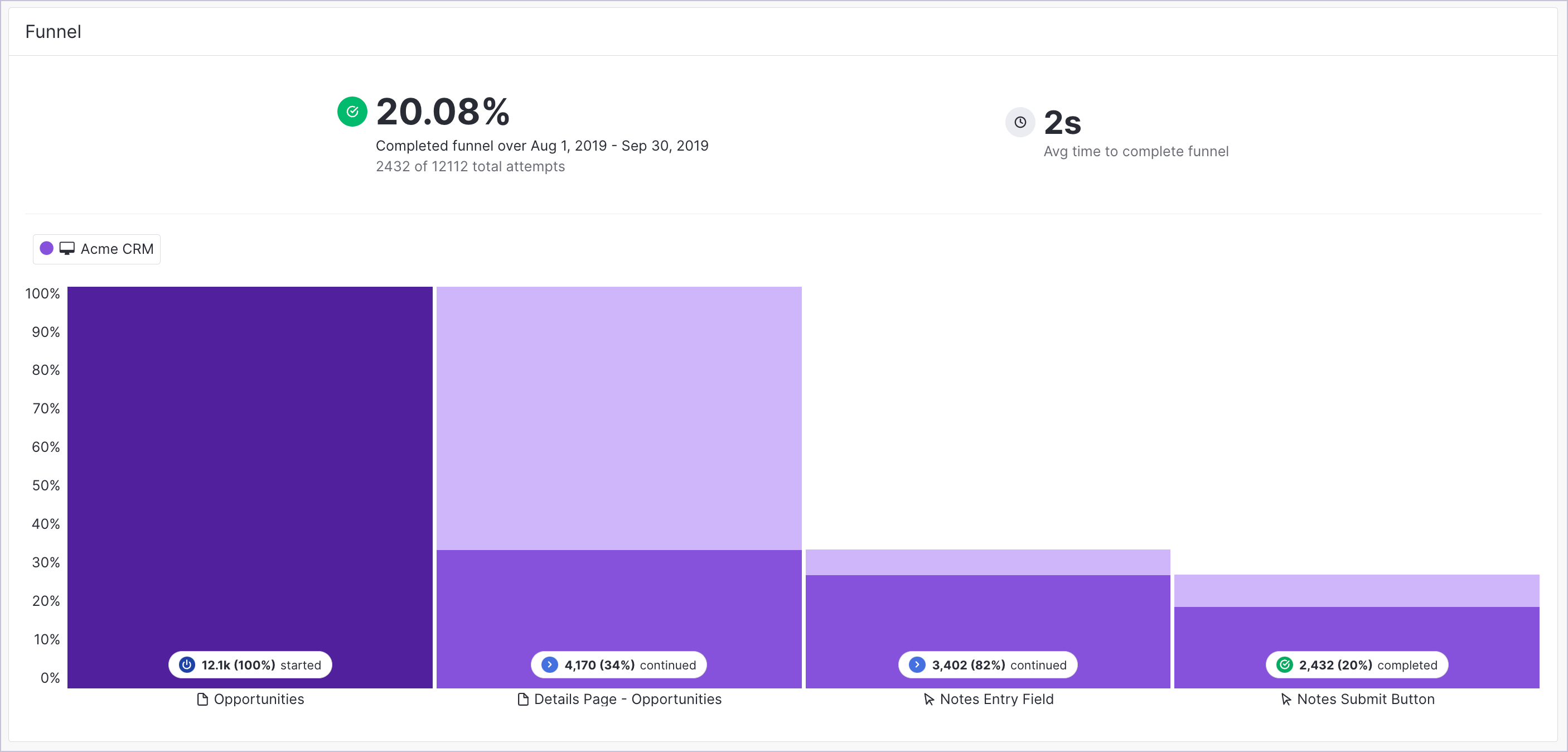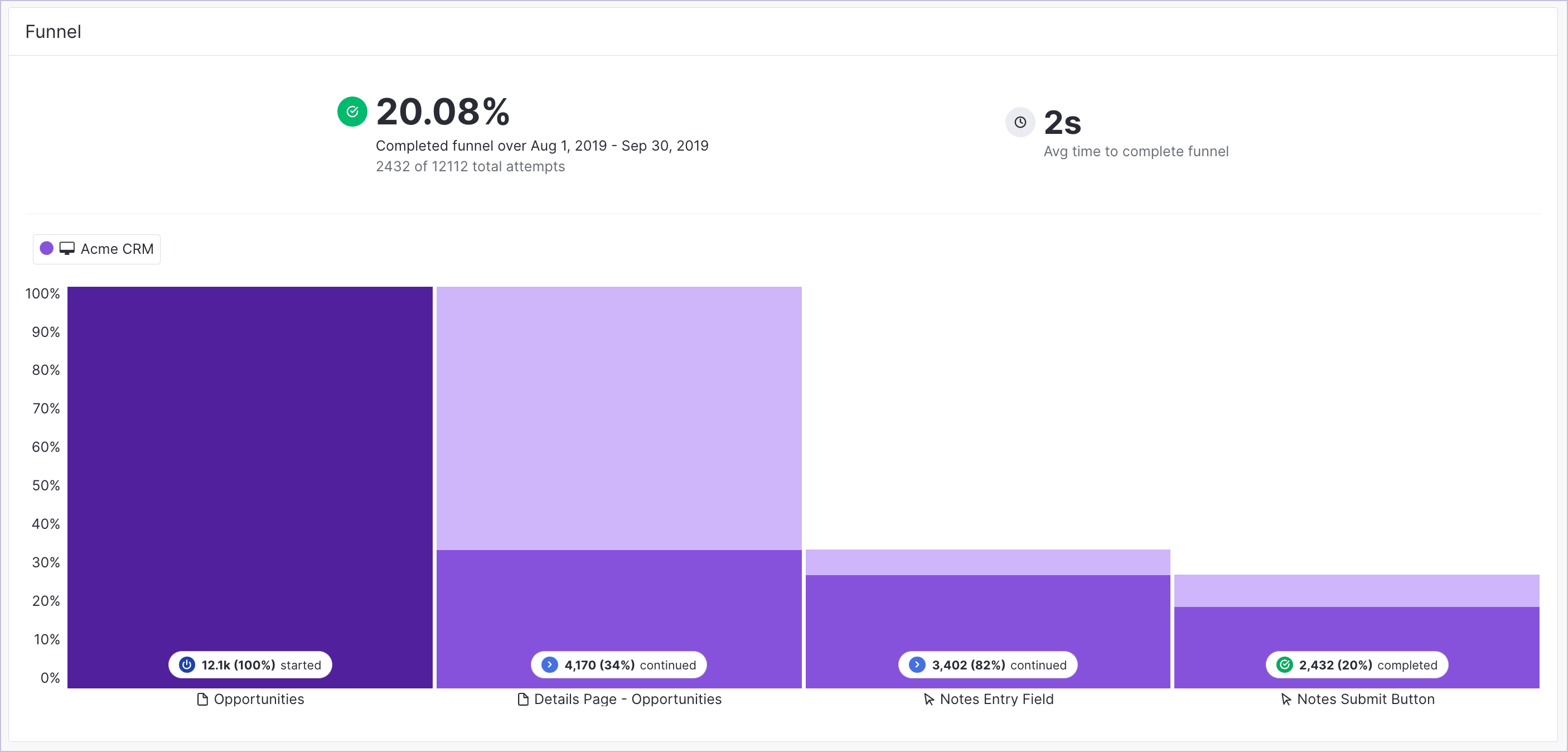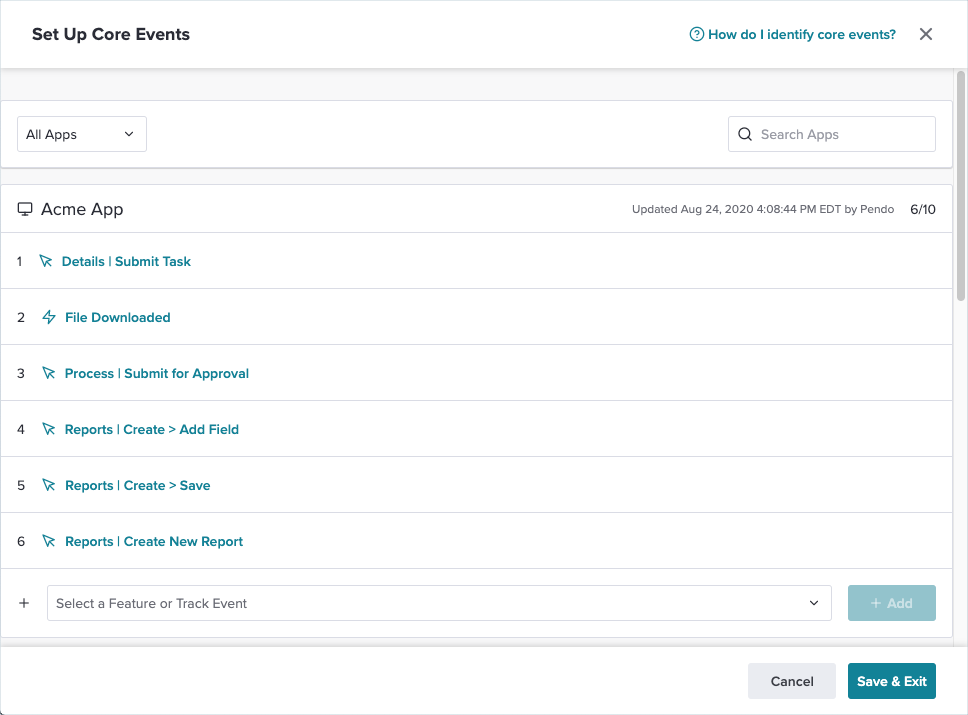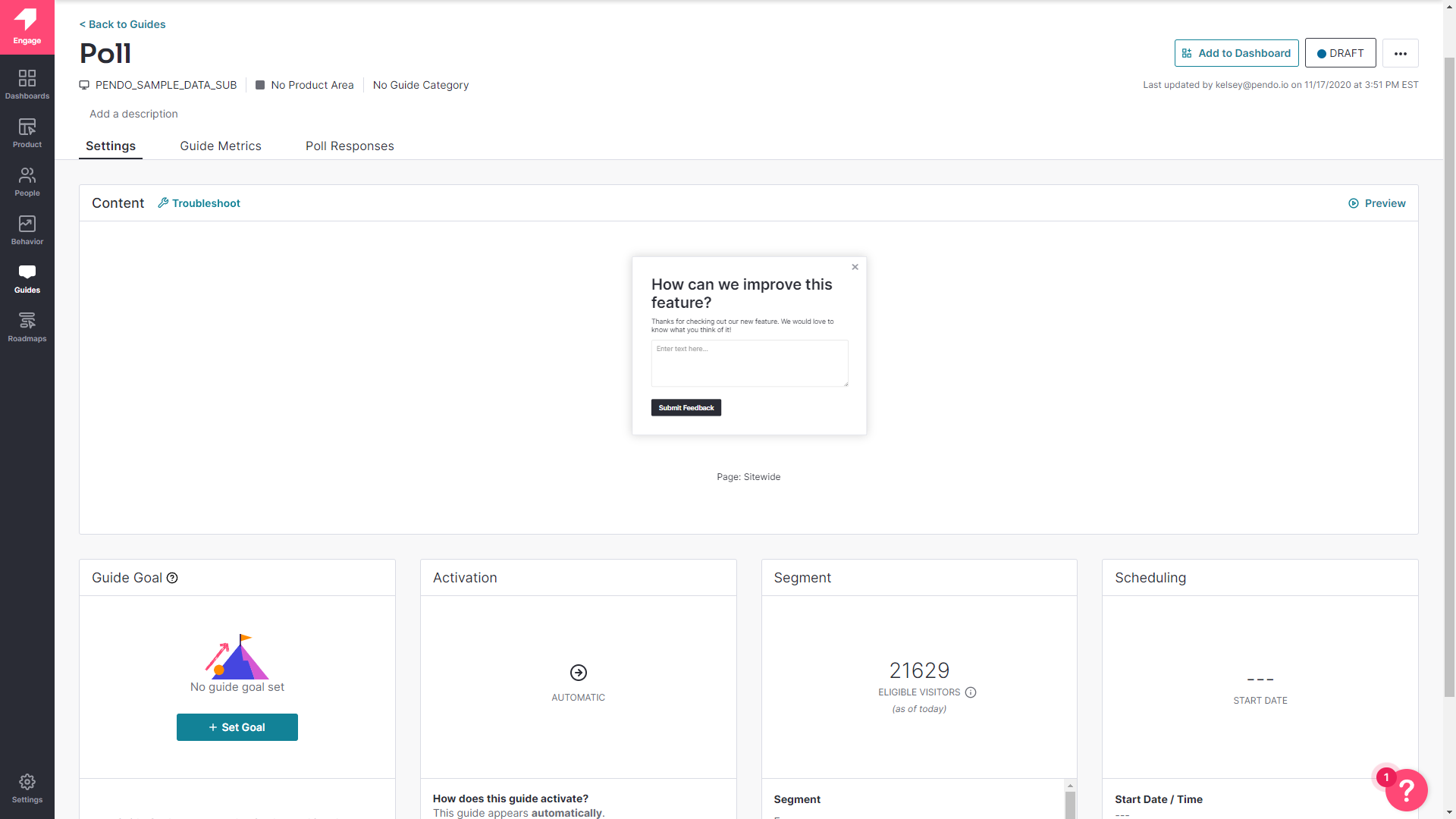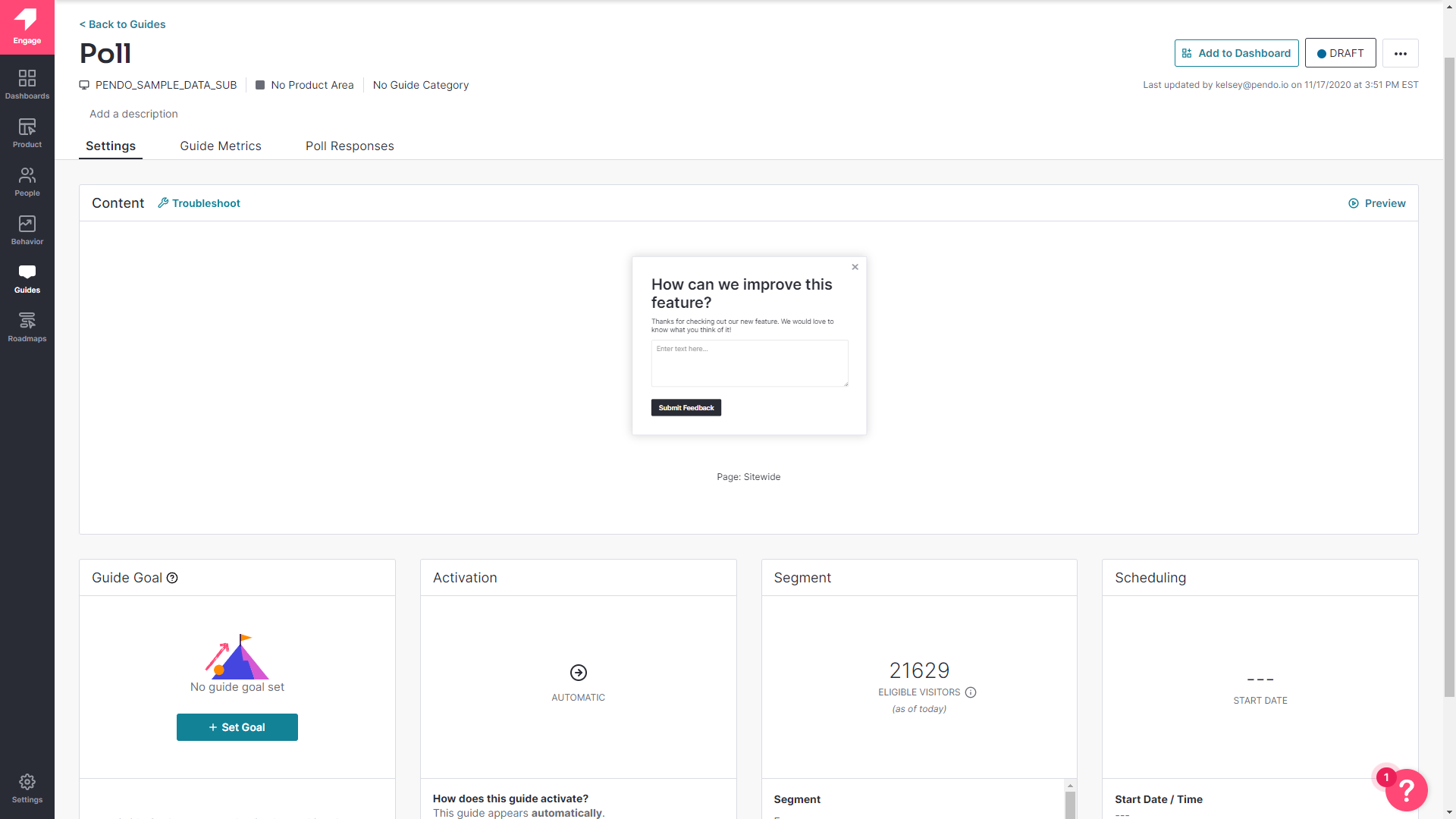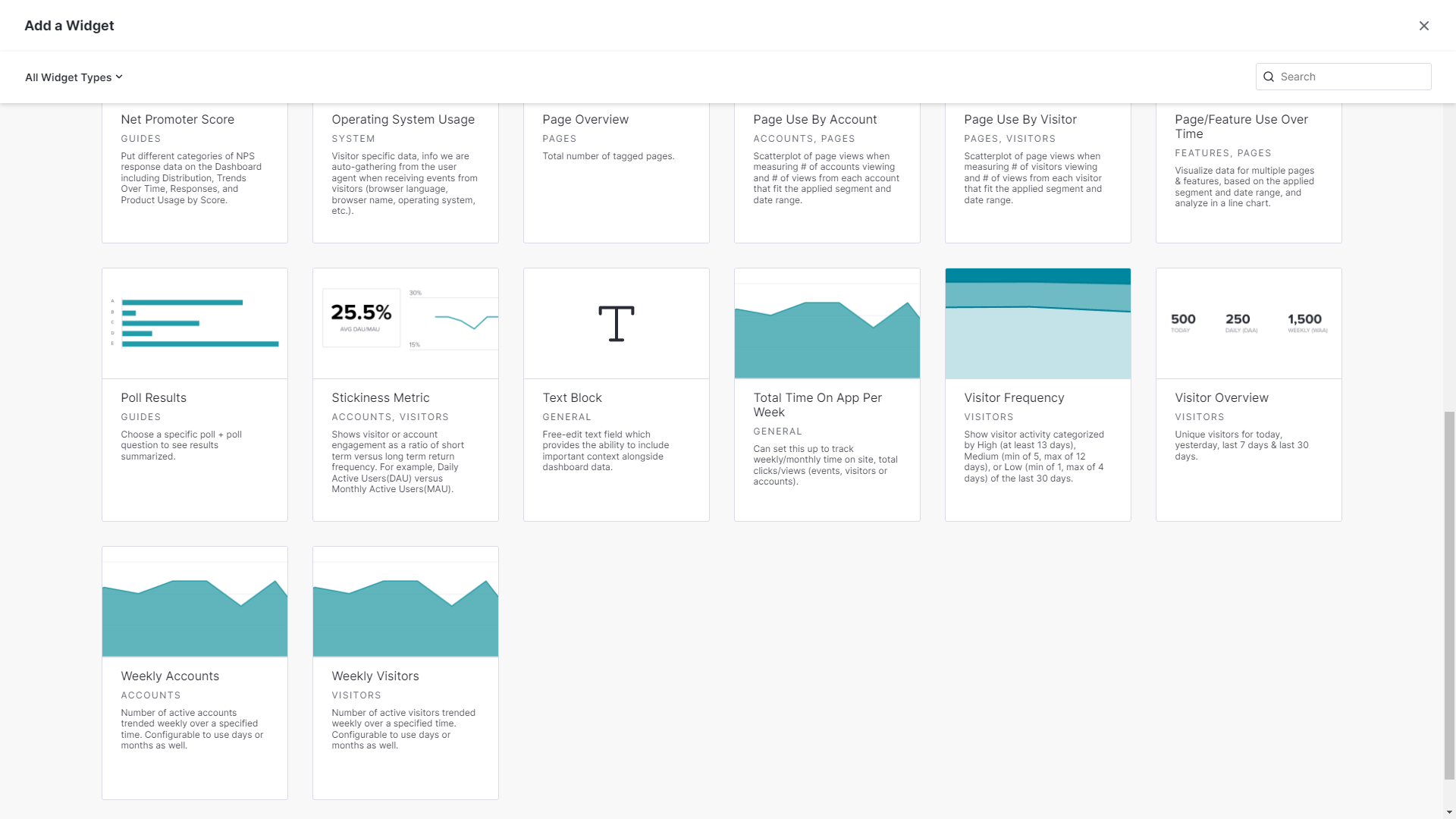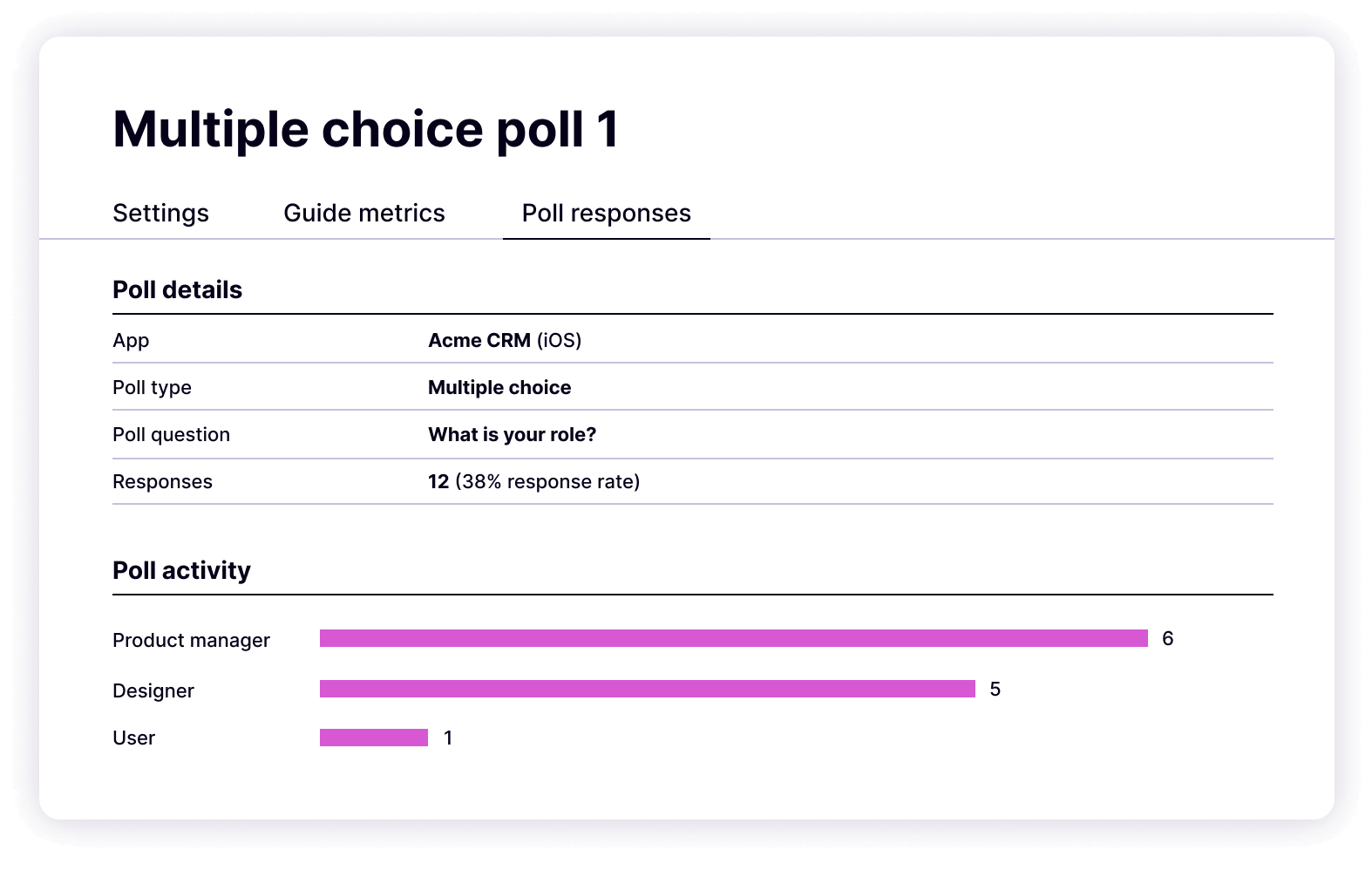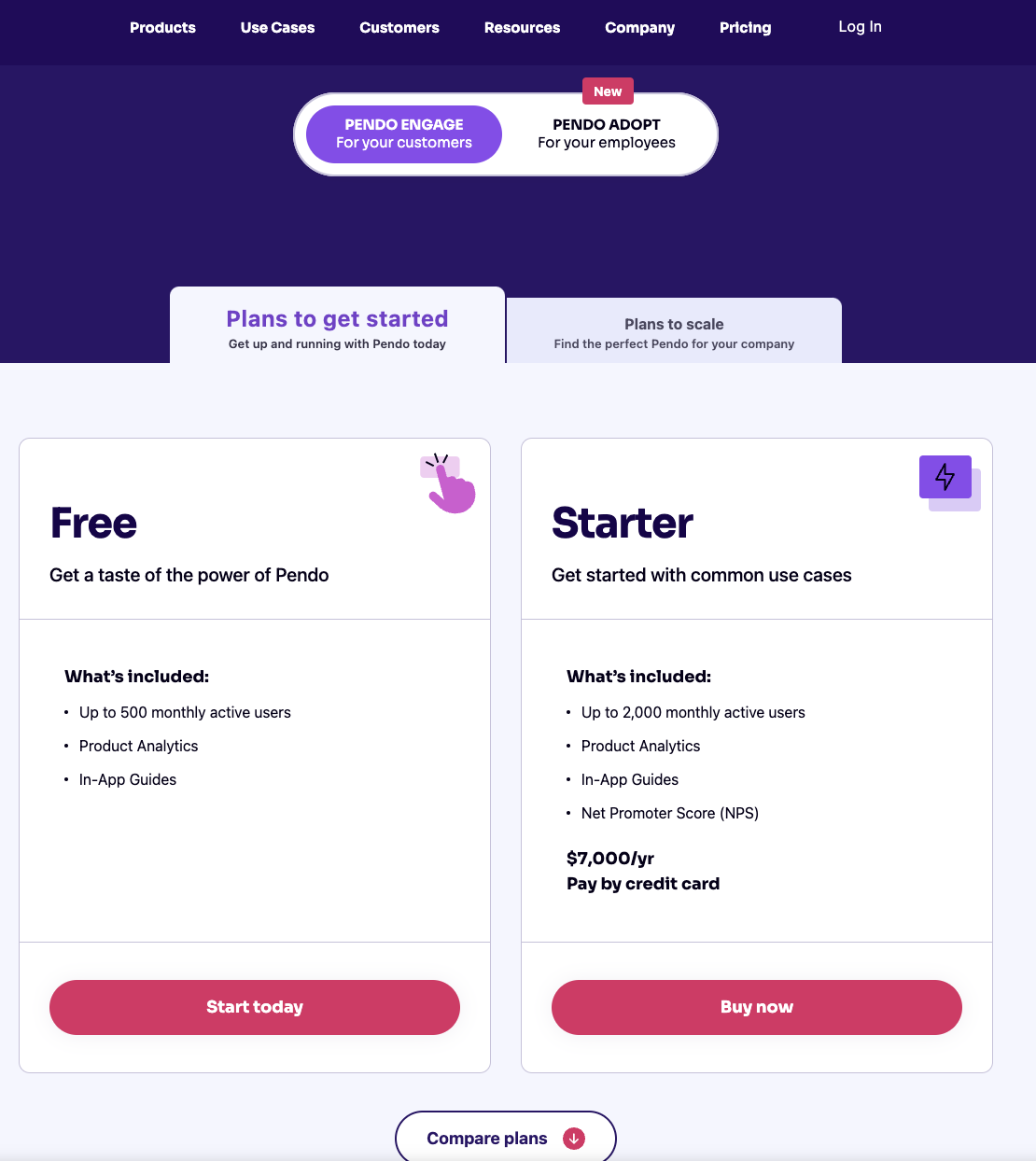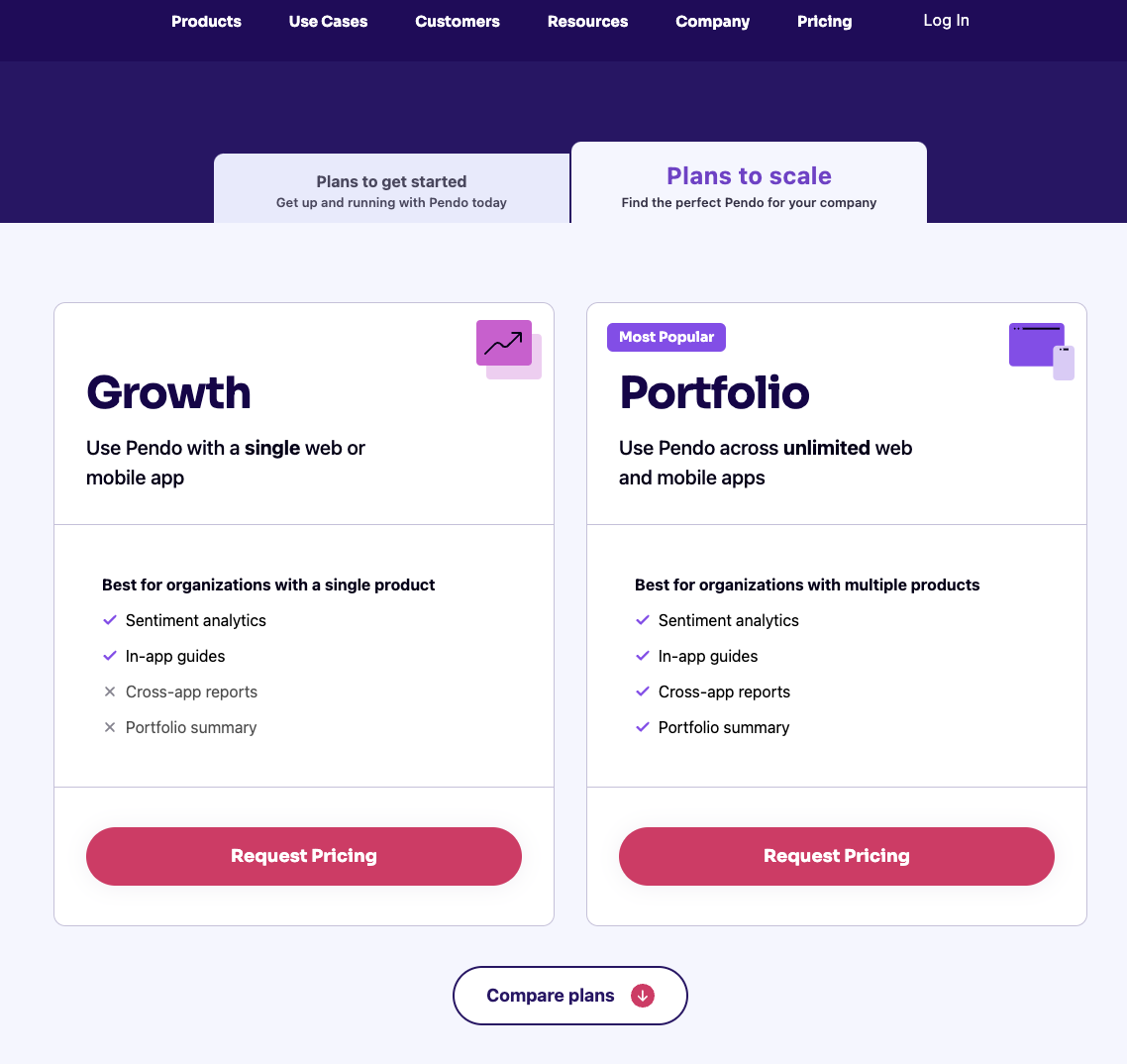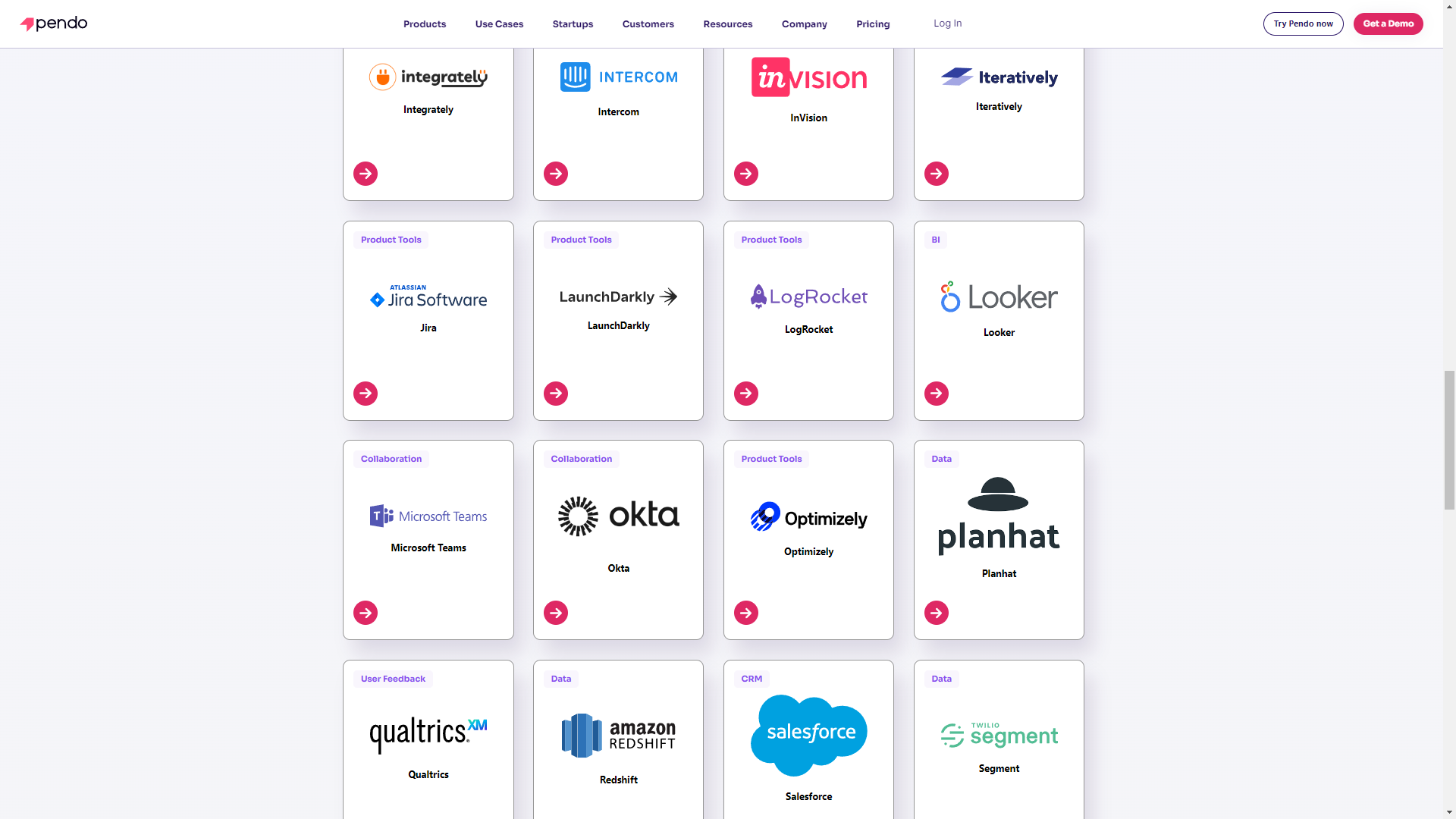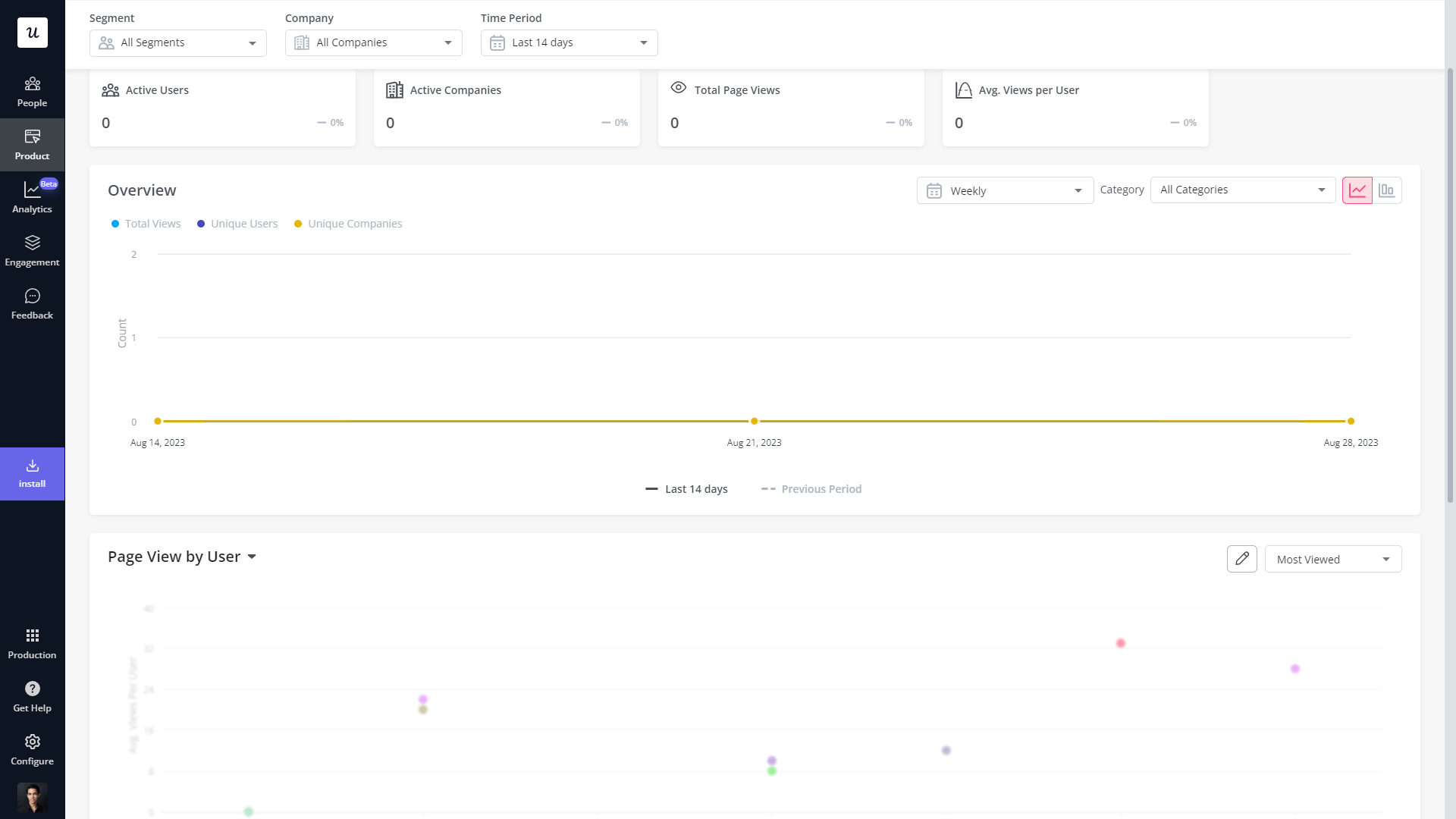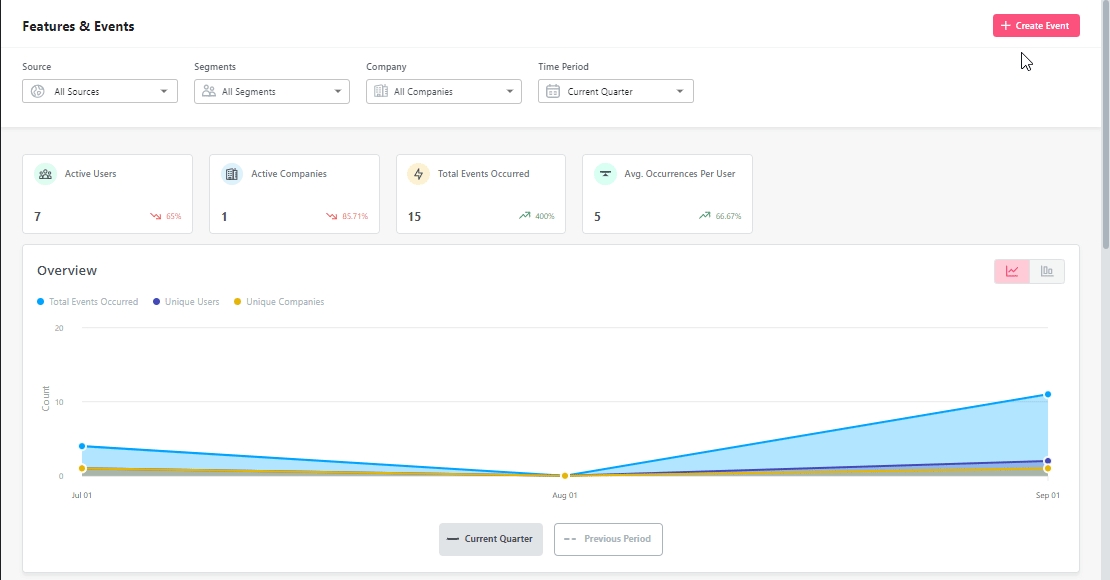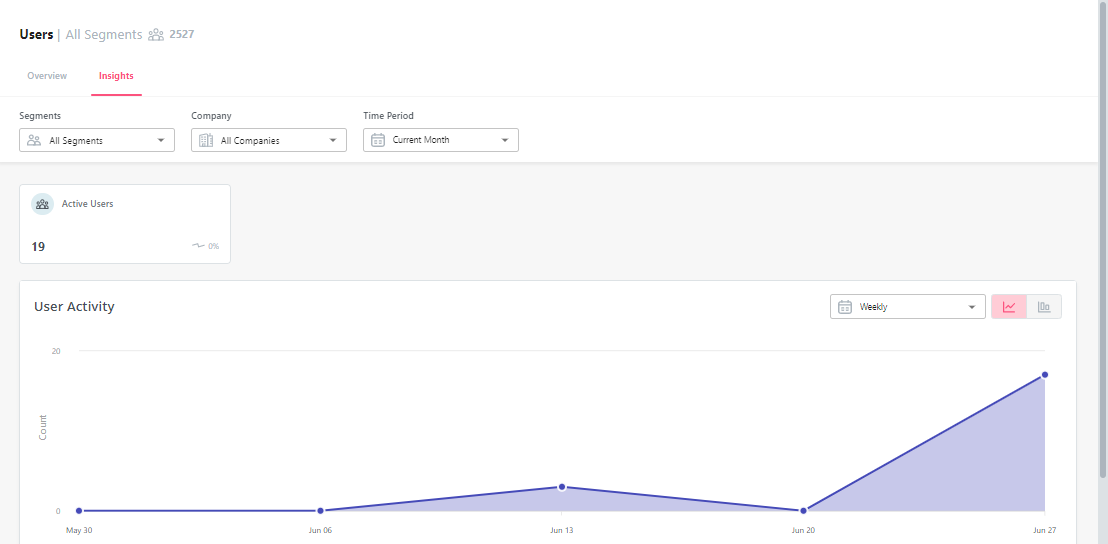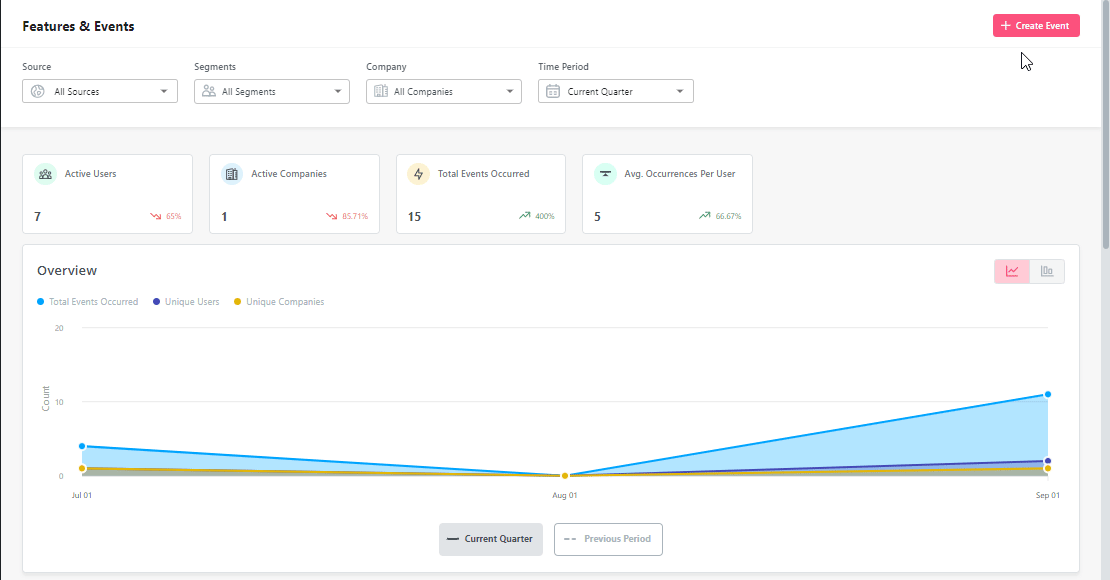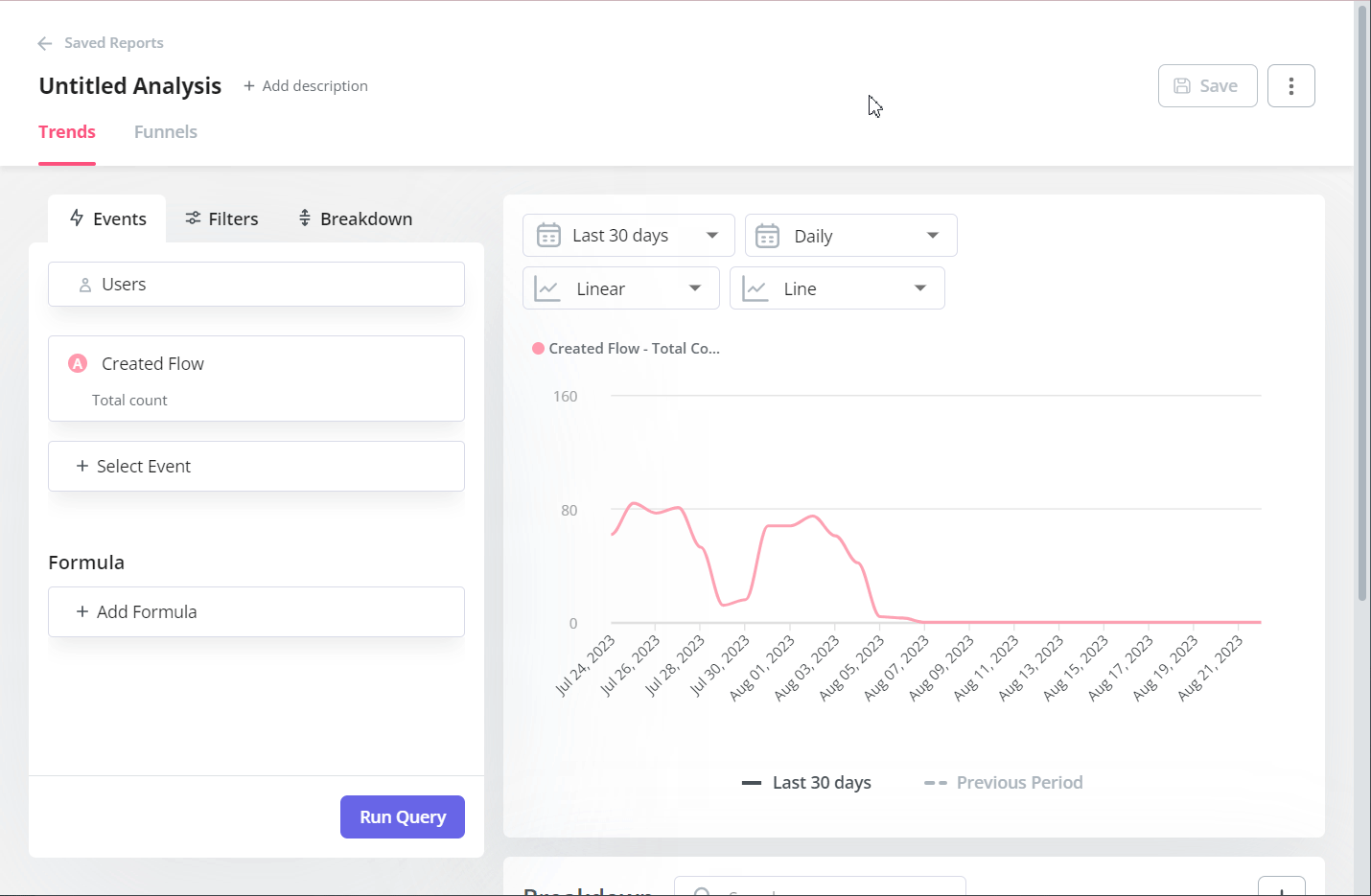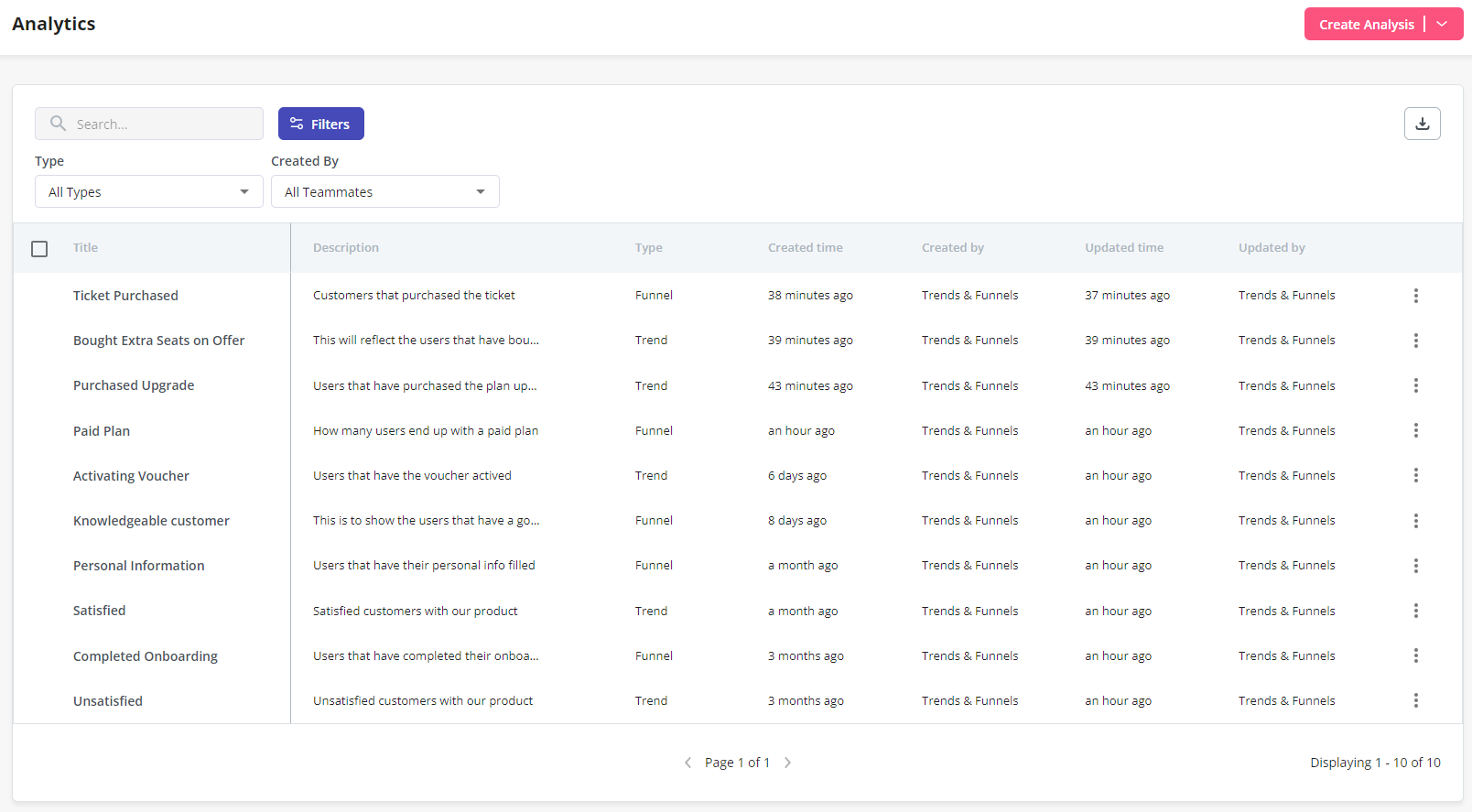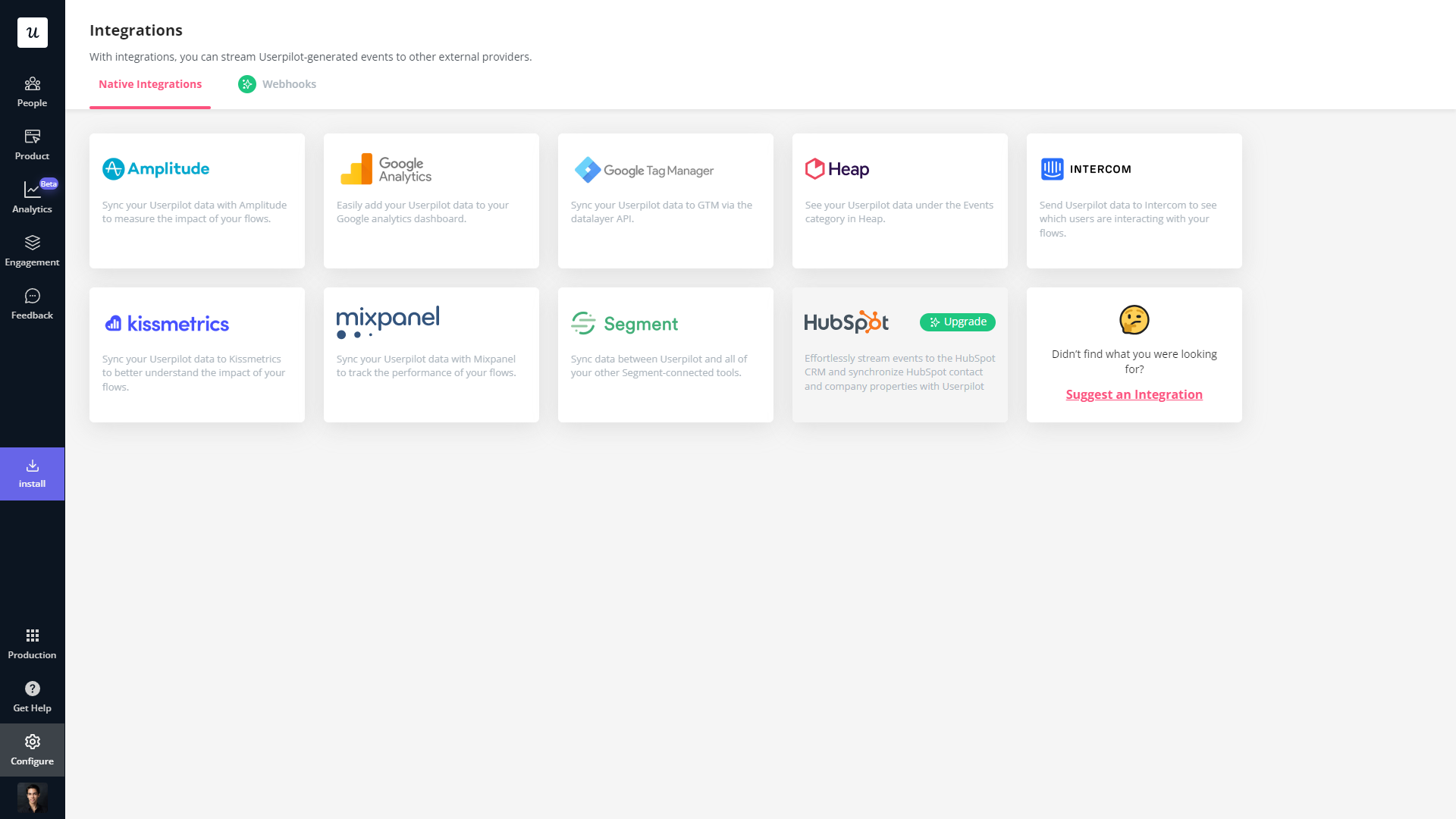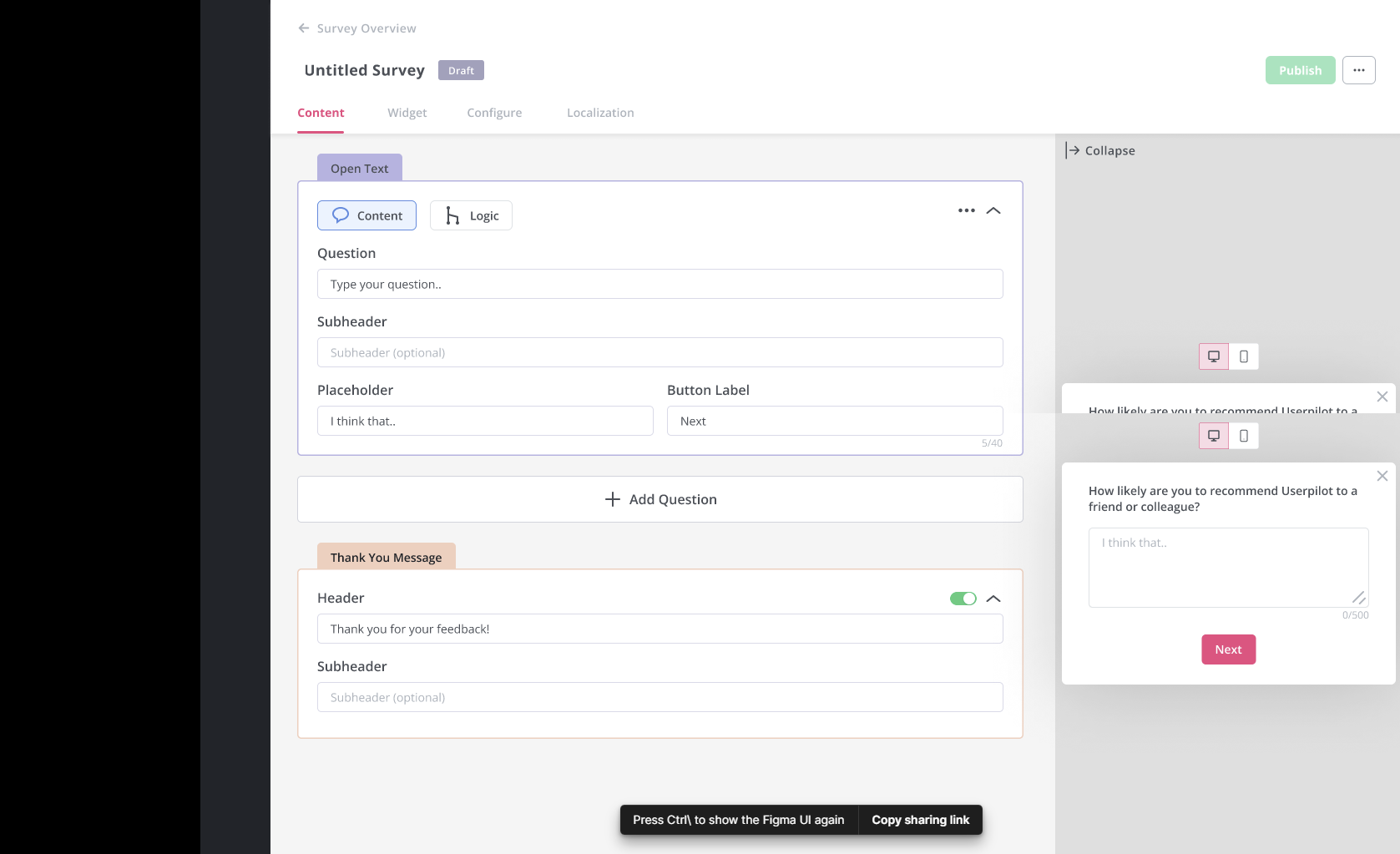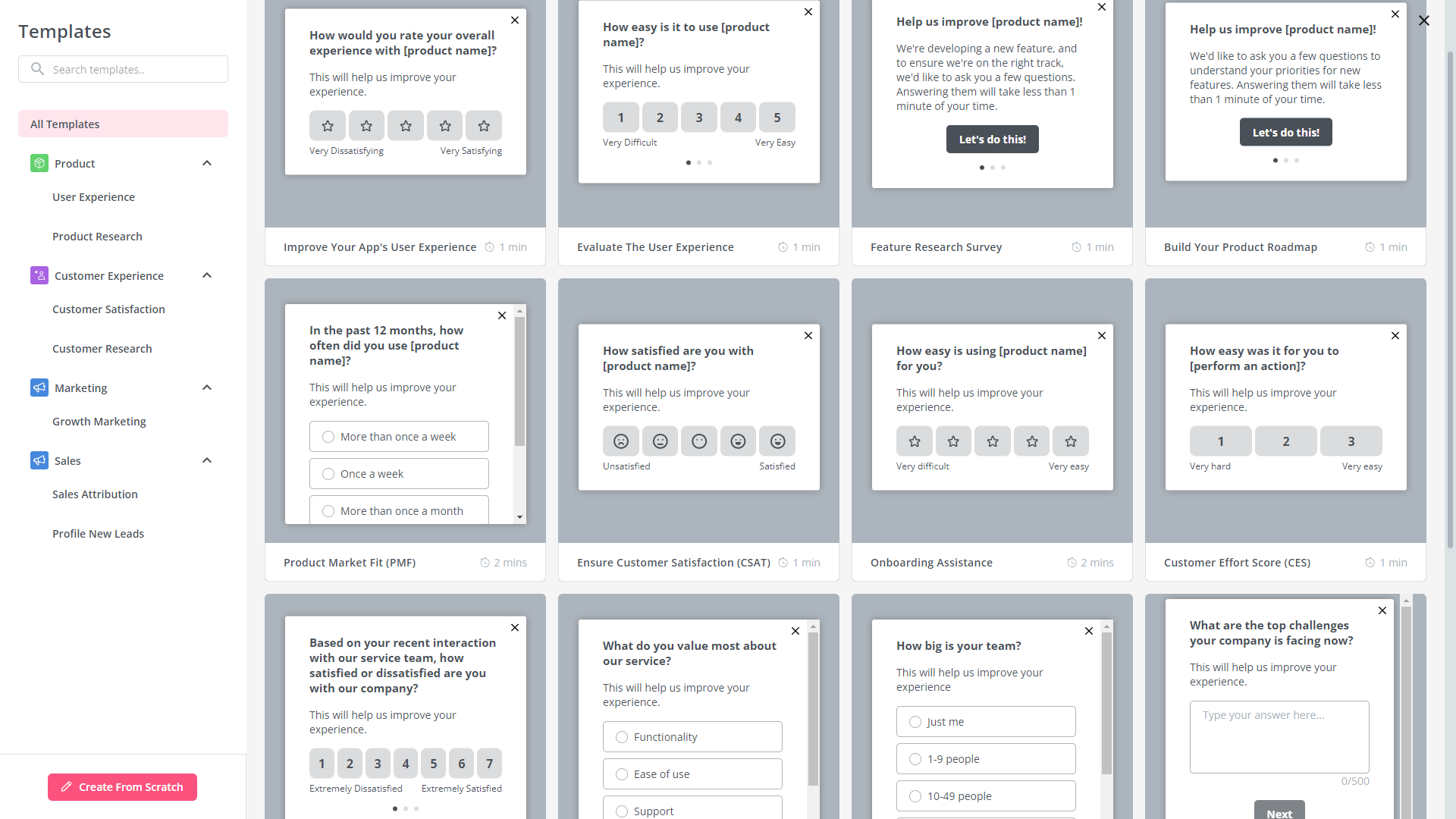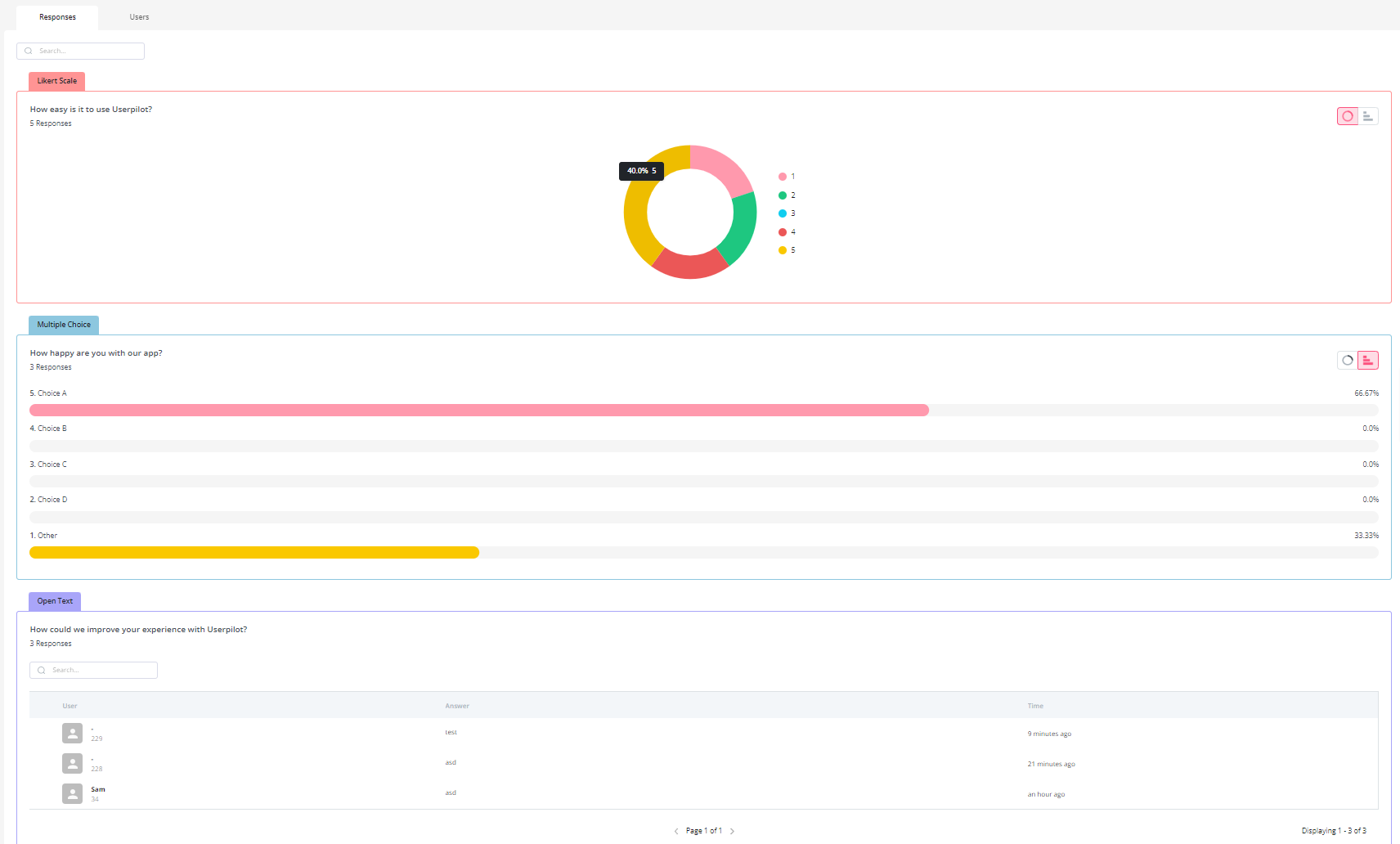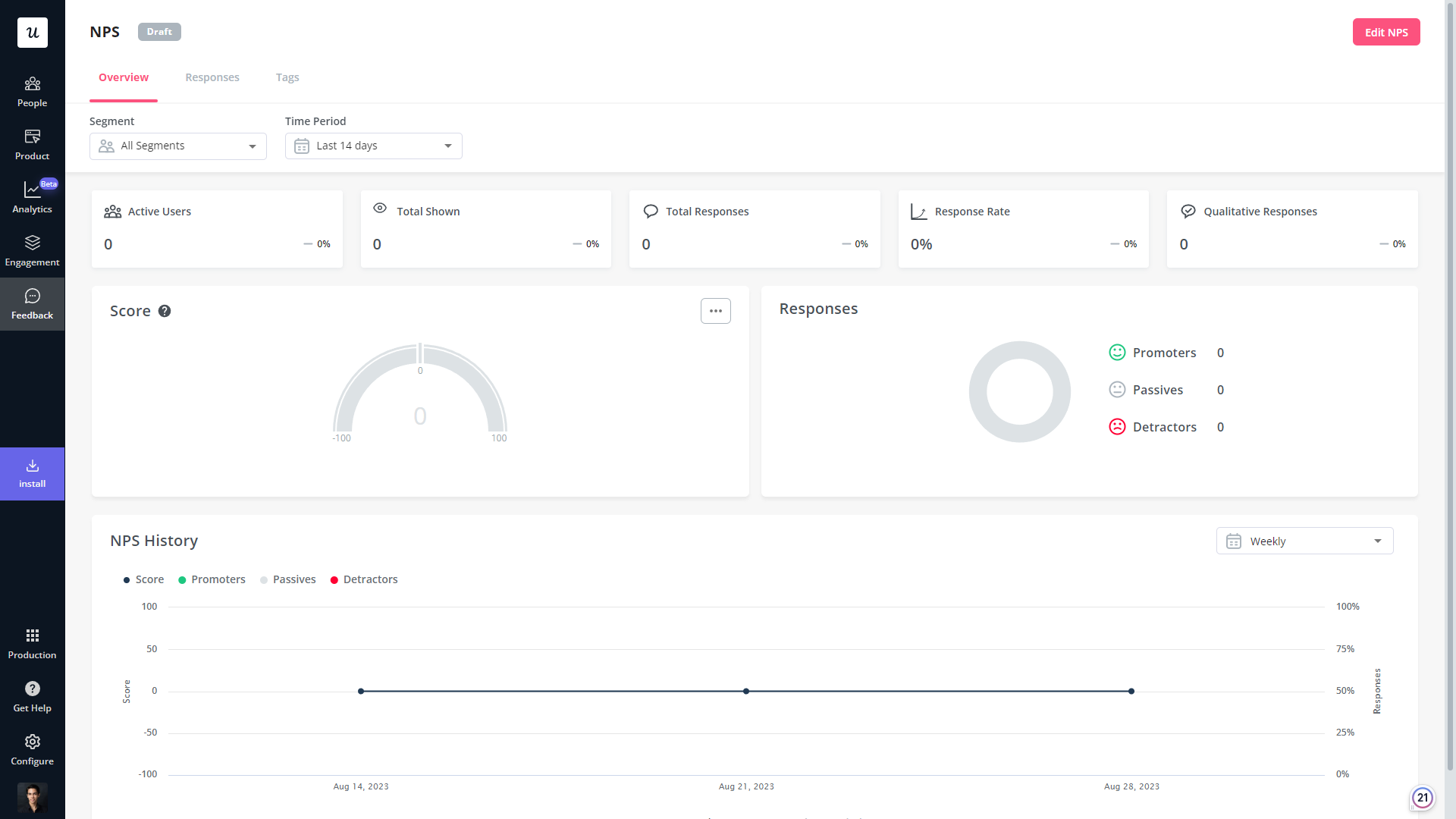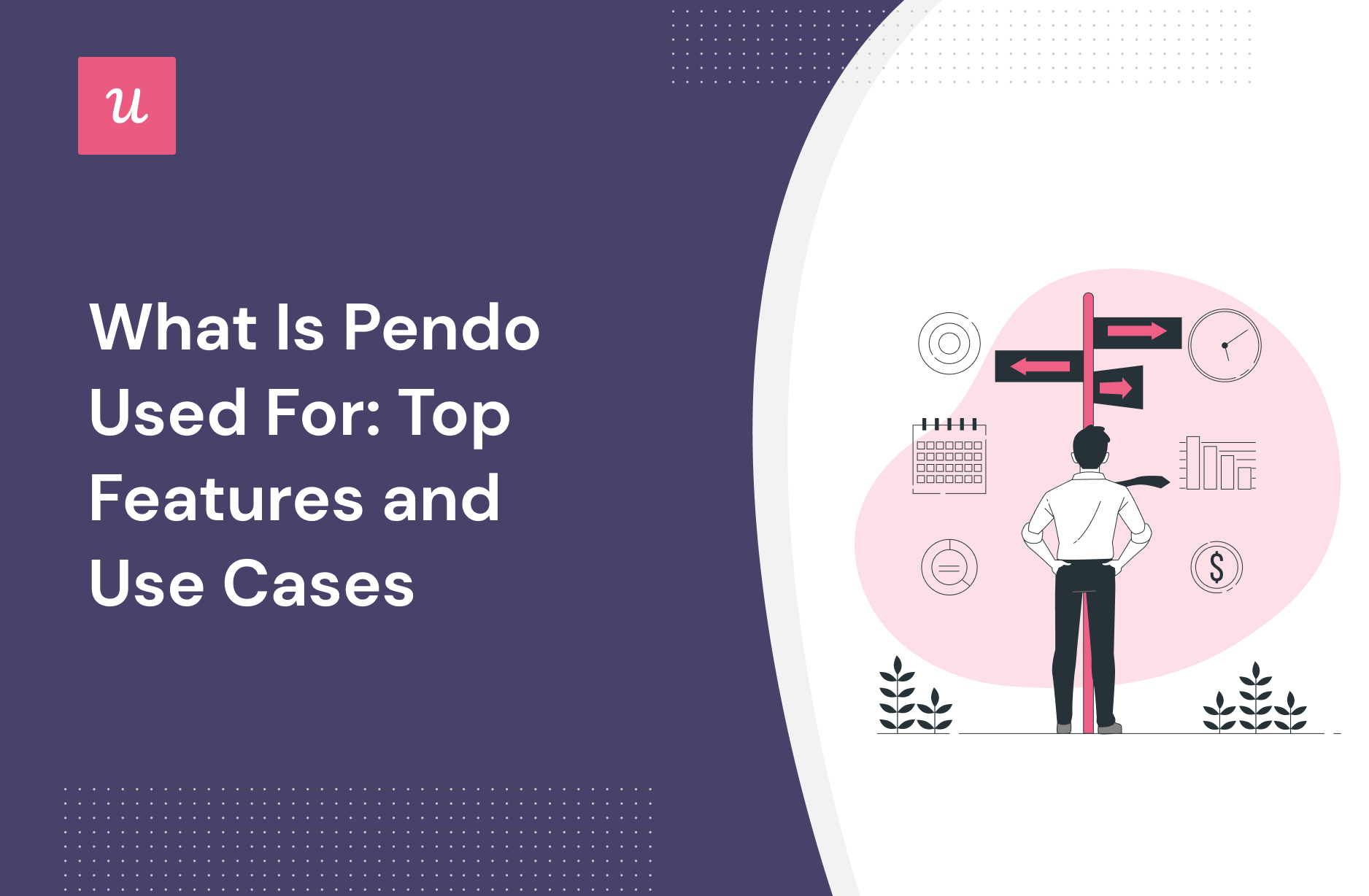
Curious about how you can use Pendo to grow your product? What are its best features and are there any drawbacks you should be aware of before investing in it?
We answer these questions in this article and dive deep into the use cases and features that Pendo offers, its pros and cons along with its pricing. We also explore an alternative tool that might interest you.
Let’s dive in.
Try Userpilot Now
See Why 1,000+ Teams Choose Userpilot

What is Pendo?
Pendo is a product adoption platform that lets teams monitor product usage, analyze user behavior, and publish in-app guides. The no-code solution focuses on increasing user engagement and driving feature discovery.
Additionally, Pendo also lets you survey users, segment customers, and see how many site visitors or MAUs your web app is getting. Certain features like product areas, data explorer, product engagement score, and resource centers are locked to the Starter plan or higher.
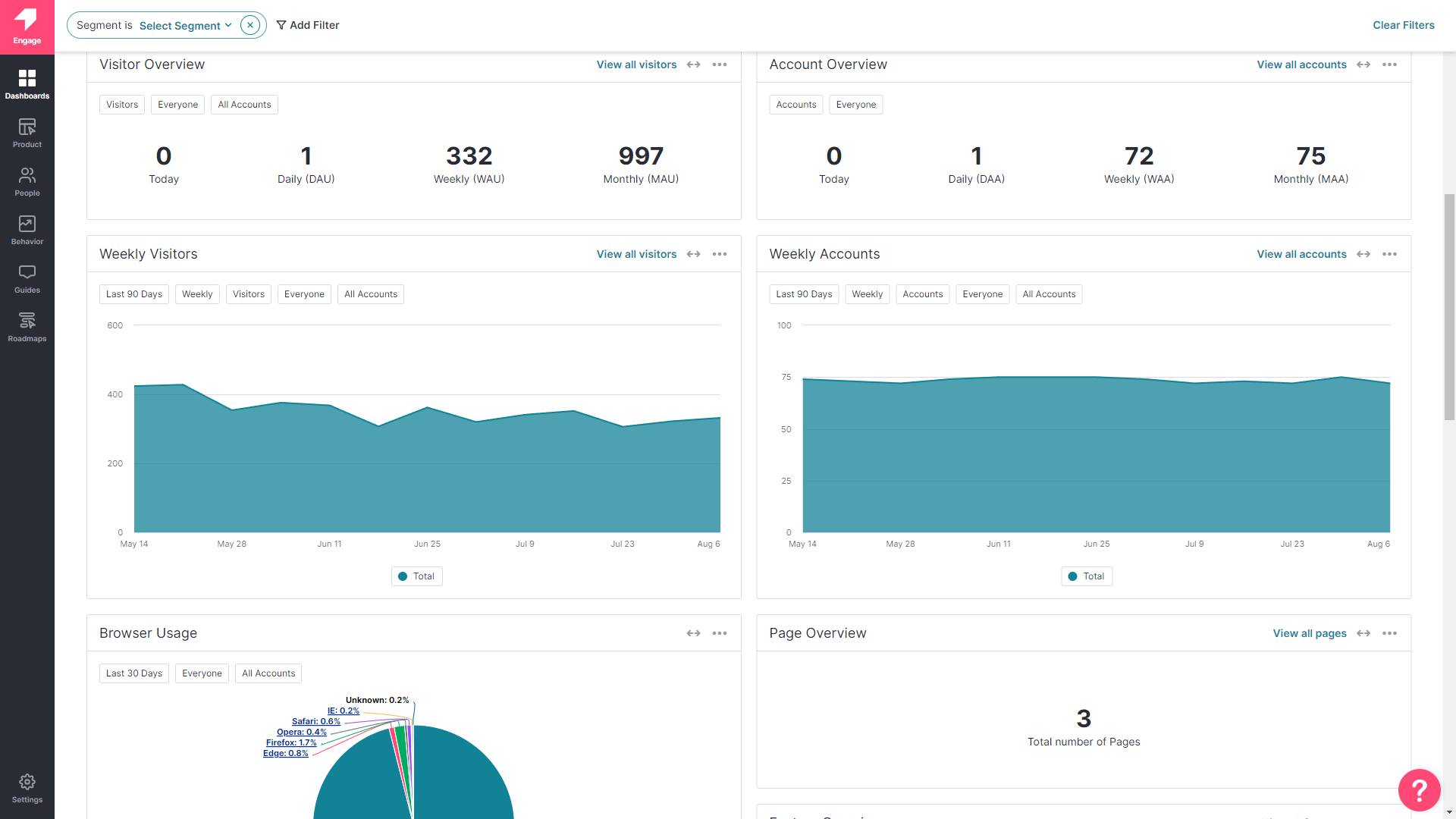
What is Pendo used for?
Pendo can be used in multiple ways to grow your company, but we’ll be going into detail regarding the below use cases and their respective features:
- Product adoption
- Product analytics
- User feedback
Pendo’s main use case: product adoption
Because product adoption is the primary use case for the Pendo platform, most of its features contribute towards onboarding users, tracking adoption analytics, monitoring usage patterns, or measuring churn rates.
Pendo’s product adoption features include:
- Product Analytics: Pendo analytics can show you patterns in user behavior, underutilized areas of your product, and other usage data. Pendo divides its analytics into funnels, paths, and retention — the latter of which is capable of tracking cohort churn over time (months or weeks).
- Feature Engagement: Pendo’s dashboard widgets let you see feature engagement from multiple lenses to ensure you get the full picture. You’ll be able to view the features that generate the majority of click volume and track features used by accounts/visitors.
- Build guides to drive engagement: Pendo has layout templates for lightboxes, banners, and tooltips that you can use to build onboarding flows for new users.
- Feedback Collection: Pendo can gather user feedback through polls, input fields, and NPS surveys. Its NPS surveys can be delivered both in-app and via email while giving the option to include follow-up questions that provide qualitative feedback.
Note: Pendo in-app resource centers can only be created if you’re on the Growth or Portfolio plan.
Pendo’s functionality for product adoption: user onboarding
Pendo is a product adoption platform that has the usual onboarding features that are commonly included with similar solutions. However, those using Pendo Free will need to note that they’ll need to find a new onboarding solution once they cross 500 MAUs or upgrade to the paid version.
There are a few ways you can use Pendo to improve your new user onboarding flows:
- Guide Layouts: Pendo has layout templates for lightboxes, banners, and tooltips that you can use to build onboarding flows for new users.
- Flow Triggers: Pendo’s guide activation options let you trigger an onboarding flow when new users land on a particular URL, use a specific device type, interact with a tagged element, or match the target segment.
- Localization Settings: Localization settings can stop an onboarding flow from triggering if it hasn’t been translated into the user’s chosen language. Because Pendo has no AI-powered localization features, you’ll need to upload language CSVs manually for this to work.
- Onboarding Module: You can add the onboarding module to your in-app resource center in two clicks then change the color, text style, and progress icon to align it with your product’s brand palette.
Pendo’s functionality for product adoption: in-app support
In-app support includes everything from chatbots to product documentation and the human representatives on your support team that respond to live chat requests. Implementing in-app support elements in your product can reduce the learning curve and cut down on support costs.
Here are three Pendo features you can use to improve in-app support:
- Intercom Integration: Pendo’s integration with Intercom makes it possible to embed a live chat into your in-app resource center so users can get real-time support at any point in their product tour.
- In-App Resource Center: Pendo’s in-app resource center is a great place to store self-support documentation for users. You can also tinker with segmentation settings to tailor the visible content to different groups (e.g. new users) or use analytics to see the most-viewed modules. You can add guides, checklists, and announcements or get feedback from users. The downside is that is missing a search button which can make it hard for users to scroll through several resources to find what they need.
- Support Tooltips: Tooltips are a proactive way to answer questions before users even ask them and deflect recurring support tickets so your representatives have more time to work on complex cases.
Looking for the best tool for product adoption? Search no more!

Pendo’s main use case: product analytics
Pendo has no shortage of product analytics capabilities as both native features and third-party integrations. You’ll even be able to access the most important metrics like MAUs and feature use from the home dashboard itself.
Here’s a closer look at Pendo’s analytics features:
- Native Analytics: Because Pendo is a product adoption platform, most of its adoption and engagement analytics are native to the solution. This means you’ll be able to track the number of views, clicks, and interactions that specific in-app guides or product areas get.
- Paths: The Paths section of your Pendo account shows you which paths users take when coming from a specific page or which path they took to get to a particular page. You’ll also be able to sort this data by segment, date, or see the paths taken by individual visitor IDs.
- Retention: Pendo’s retention analytics dashboard lets you see cohort retention data from month to month. You’ll also be able to toggle between visitors versus accounts, switch between weekly or monthly views, and measure retention for specific segments.
- Funnels: Pendo’s funnel analytics can tell you how many unique visitors have seen your funnels, how many attempts have been made to get through the funnel, and the average time it takes to complete the funnel. You’ll also be able to see completion rates and sort by date or segment.
- Analytics Widgets: Pendo’s home dashboard lets you choose which widgets you’d like to add or remove. You’ll be able to select from various analytics widgets that track product goals, feature adoption, guide views, time-on-app, and other core metrics.
- Third-Party Integrations: Pendo has integrations with tools like Salesforce, Intercom, Segment, Slack, and more. Linking your Pendo account with these third-party solutions will make syncing and sharing data seamless (but do note that Pendo doesn’t update analytics in real time).
Note: Pendo’s HubSpot integration is a one-way integration, which means you won’t be able to sync data both ways between the two tools. You’ll need to upgrade to the Growth plan or higher to use Pendo integrations.
Pendo’s functionality for product analytics: funnels
User funnels help you track the customer journey from the awareness stage to conversion or even advocacy. Pendo helps you track user funnels through a combination of funnel charts, path reports, and data export capabilities.
Here are the Pendo features you can use for funnel analysis and tracking:
- Funnel Charts: Pendo lets you generate funnel charts that help you visualize multi-step funnels, see which stages most users get stuck on, and view the average completion time for each funnel within your product. You’ll also be able to track the overall completion rate of funnels.
- Paths Reports: Pendo’s Paths reports help you view the paths that users take when coming from a specific page. You can also duplicate these reports, share them with other team members, or download the report as a CSV file with up to 10,000 rows.
- Step Breakdown: If the visual charts on Pendo aren’t the right fit for your use case then you could export your funnel data as a step breakdown CSV file. This will give you data on the total number of unique visitors a funnel got, the conversion rate on each step, and step duration.
Pendo’s functionality for product analytics: event tracking
In-app events encompass all events that users take after they create an account or install your product. These include events like completing an onboarding tutorial, making their first purchase, trying out a feature, and more.
Here’s a quick overview of Pendo’s event-tracking features:
- No-Code Core Events: The core events feature on Pendo makes it easier to track the events, actions, pages, or features that are responsible for the majority of product adoption. You can use any tagged event, page, or feature to create up to 10 core events per product.
- Event Dashboard: The event tracking dashboard on Pendo shows you the name of each event, which product area it occurred in, and various quantitative data points. Do note that you’ll only be able to use the product areas feature if you upgrade to the $7,000/year Starter plan.
- Mobile Events: Pendo supports mobile event tracking for both iOS and Android operating systems. Examples would be tapping on a particular button, leaving app store reviews, reaching time-on-app milestones, and other mobile event data.
Pendo’s main use case: user feedback
User feedback is crucial to growth as it can guide both product development and marketing initiatives. Pendo’s native analytics mostly focus on product analytics and behavioral data but it does have some features that focus on gathering user feedback.
Here are Pendo’s main user feedback features:
- Polls: Pendo lets you create multiple-choice polls with analytics for the number of responses, overall response rate, and which options got the most votes. You’ll also be able to view poll responses from your home dashboard by adding the poll widget.
- NPS Surveys: Creating NPS surveys with Pendo is fairly easy as you’re able to target specific segments, ask a follow-up question, and select the delivery method (either in-app only or combined with email). You can also integrate Pendo with Slack to set up response forwarding.
- Feedback Module: You can add a feedback module to your in-app resource center in two clicks. This gives users a chance to share their thoughts on the available resources, overall product experience, or specific issues they’ve been facing.
Pendo’s functionality for user feedback: in-app surveys
In-app surveys yield higher response rates than email surveys and offer more accurate feedback because they give users the opportunity to share their thoughts as they’re actively using the product. However, Pendo’s polling features may not be as expansive as other survey tools.
Here are some of the benefits you could reap by using Pendo polls:
- Segmentation: You can target individual segments with Pendo polls to ensure that you get responses from the most suitable customers. For instance, you could poll new users on how their onboarding experience went or power users on which features they like the most.
- Analytics: Pendo’s analytics dashboard shows you the response rate for all your polls as well as which options got the most votes (for multiple-choice polls). You’ll also be able to add poll analytics to your Pendo homepage in the form of a widget.
- NPS: Pendo has a separate feature for NPS surveys that offers more advanced customization and analytics options than its standard polls. You’ll be able to choose how the survey is delivered, what follow-up question to ask, and what success message to display.
Note: All NPS surveys include Pendo branding that can only be removed by upgrading to the $7,000/year Starter plan.
Pendo’s functionality for user feedback: survey analytics
Pendo’s survey analytics may not be as comprehensive as its product analytics but if basic feedback collection is all you need then it should be sufficient. Pendo lets you add poll widgets to your home dashboard, track poll response rates, and collect qualitative and quantitative feedback.
Here’s an overview of Pendo’s survey data analysis capabilities:
- Poll Widget: Pendo’s poll widget can be added to the home dashboard to track responses and metrics. Sadly, each widget can only track one poll and it only shows summarized data rather than showing you the full responses.
- Combined Insights: Pendo’s in-app polls let you collect a combination of qualitative and quantitative feedback. Combining these two types of survey data from Pendo polls can help you extract insights and dispel any interpretation bias.
- Response Rate: Every poll displays the overall response rate so you don’t have the manually calculate this metric. While Pendo doesn’t have any built-in A/B testing for polls, you can use the response rate metric to compare polls and see which ones get the most engagement.
How much does Pendo cost?
Pricing for most paid Pendo plans (except Starter) is only provided on a quote basis and there are no listed price ranges on the solution’s website. That said, certain reviews have stated that prices start at upwards of $20,000 per year for a single product and more than twice that for higher plans.
Pendo has three paid plans and one free version that is limited to 500 MAUs which makes it accessible to startups but difficult to scale in the long run.
Here are the differences between each Pendo plan:
- Pendo Free: The free version of Pendo can accommodate 500 MAUs and has features like native analytics dashboards, feature tagging, event tracking, segmentation, NPS surveys (with Pendo branding), analytics reports, and in-app guides.
- Growth: Pendo’s Growth plan is designed to be used for a single web or mobile app but can accommodate a custom number of MAUs. It includes features like native analytics dashboards., in-app guides, NPS surveys and response tracking, and customer support.
- Starter: The Starter plan starts at $7,000 per year (or $2,000 per quarter) for 2,000 MAUs and is the cheapest upgrade option available for freemium users. Starter includes features like Product Areas, NPS surveys without Pendo branding, and (limited) NPS analytics. Note: You’ll need to upgrade to the Growth or Portfolio plan to get full NPS analytics.
- Portfolio: Pendo’s Portfolio plan is targeted towards customers who want to use the tool for multiple web and/or mobile apps. Features include guide experiment capabilities, cross-app executive dashboards, cross-app journey reporting, and access to product engagement scores.
Benefits of using Pendo
Let’s take a look at some of the benefits of using Pendo:
- No-Code: Pendo lets you create surveys, in-app guides, and track metrics without needing to write your own code which saves a lot of time (while making product experiments or split-testing a lot easier).
- Custom Themes: Pendo’s themes let you create multiple palettes and ensure that any in-app materials published align with your existing brand palette (however you can only create/customize themes after you’ve installed the Pendo snippet).
- Flexible Dashboards: Pendo has plenty of widgets that you can add to your dashboard including feature adoption, net promoter score, poll results, guide engagement, product stickiness, and MAUs — so you always have your most important metrics within reach.
- Integrations: Pendo has 50 different integrations to choose from including popular tools like Intercom, Jira, Okta, and HubSpot. Unfortunately, only four of these — Salesforce, Segment, Workato, and Zendesk — are two-way integrations that can share data both ways.
- Multi-Platform Analytics: Because Pendo is compatible with mobile applications, you’ll be able to track product analytics for both web apps and mobile apps. This gives you a more holistic view of how users (or specific segments) use your product on different platforms. Note: You’ll need to upgrade to Pendo Portfolio to add more than one product to your account.
Drawbacks of using Pendo
While Pendo certainly has quite a few benefits that make it an appealing solution, there are also a few notable drawbacks that you should be aware of before you choose the platform as your product adoption tool:
- Pricing Jumps: While Pendo does offer a free version, it has a limit of 500 MAUs. Upon reaching the MAU limit, you’ll need to upgrade to continue using most of Pendo’s features (and paid plans tend to cost thousands of dollars per month).
- Locked Features: Key features like the data explorer, resource center, and product engagement score are locked behind the Growth or Portfolio plan.
- Data Lag: Pendo’s analytics dashboards only update once per hour. In some cases, this data lag could lead product teams to make the wrong decisions or draw false conclusions from outdated insights.
There is a better tool for your SaaS than Pendo!

Why an alternative is needed for Pendo?
There are a few obvious instances where you’ll likely need an alternative solution to Pendo — such as these use cases:
- Over 500 MAUs: If your product has more than 500 MAUs then you’ll need to subscribe to a premium Pendo plan (which tends to be significantly more expensive than other competitors on the market).
- Real-Time Analytics Needs: Companies that operate in fast-paced work sprints will likely opt for product adoption solutions with real-time analytics since Pendo’s one-hour data lag can data-driven decision-making difficult.
- Expensive Pricing Model: Pendo is more expensive than most solutions on the market and the subscription cost rises rapidly as your MAUs grow. Even if you’re on the Starter plan, you could be paying $35,000 annually once you reach 10,000 MAUs — which makes it harder to scale.
Userpilot: A better alternative to Pendo
Userpilot is a no-code digital adoption platform that has a few clear advantages over Pendo, such as:
- In-App Engagement: Userpilot has UI elements that are more customizable, the capacity to include videos/GIFs, Calendly embeds, an advanced resource center, and a user-friendly flow builder — along with standalone onboarding checklists with their own analytics.
- Product Experimentation: Userpilot has a plethora of product experimentation and A/B testing features while Pendo locks even the most basic guide experimentation capabilities behind its Portfolio plan.
- Real-Time Analytics: Userpilot updates analytics dashboards in real-time while Pendo only refreshes data once per hour (and can even take an additional 15 minutes to finish updating the data during high-volume periods).
Userpilot’s main use case: product adoption
Product adoption is when users become repeat users of your product. It covers the entire journey spanning from the awareness stage to trial signup and finally full-on adoption. As a product growth platform, Userpilot has advanced analytics capabilities for tracking adoption over time.
Here are the Userpilot features that can help you measure and improve product adoption:
- Product analytics: Userpilot lets you create trend reports to track adoption over time by feature or segment, funnel reports that show you which steps of the process most users get stuck on, and integrations with third-party analytics providers so you can sync data between tools.
- Feature engagement: Userpilot’s click-to-track feature tagger lets you see how often a feature is used and by how many people. You’ll also be able to see the top 20 events for a certain time period or create custom events that group multiple features together for clearer insights.
- Feedback collection: Userpilot has a no-code survey builder with 14 templates to choose from. You’ll be able to collect quantitative data like CSAT, CES, or NPS ratings and qualitative feedback on the strongest/weakest parts of your product straight from your users.
- User insights: The Insights dashboard lets you monitor user activity based on which segment they’re in and which company they’re from. You’ll also be able to choose from daily, weekly, and monthly time periods to see if user activity is shifting towards full product adoption over time.
Userpilot’s main use case: product analytics
Product analytics lets you collect and analyze data about how users interact with your product so you can extract actionable insights. Userpilot lets you look at granular product analytics such as which features have the highest adoption rates and big-picture insights like trend reports.
Here are Userpilot’s top product analytics features:
- Feature tagging: Userpilot’s click-to-track feature tagger lets you view how many times a feature has been used and by how many users to measure its adoption. Users on the Starter plan can add up to 15 feature tags while those on the Growth or Enterprise tier can create unlimited tags.
- Trends and funnels: Userpilot’s trends and funnels report lets you extract actionable insights from big data. You’ll be able to see which stage of an onboarding/conversion funnel most users drop out on and create trend reports with detailed breakdowns by user or time period.
- Saved reports: The saved reports analytics dashboard shows you all the reports you’ve created and lets you filter, export, or delete any reports in a single click. In addition to adding filters or sorting by report type, you can also edit or duplicate reports to help you review analytics.
- Analytics integrations: Userpilot integrates with some of the most popular analytics tools like Amplitude, Mixpanel, Segment, Google Analytics, and more. This makes it possible to sync product analytics both ways between the tools in your tech stack.
Userpilot’s main use case: user feedback
User feedback is an essential part of listening to the Voice of the Customer (VoC) and making product development or marketing decisions that best suit your customer base. Userpilot has a no-code survey builder, 14 templates to choose from, and advanced analytics for extracting insights.
Here are the Userpilot features you can use to collect customer feedback and analyze it:
- Survey builder: Userpilot’s survey builder lets you edit the content, update the widget’s style/placement, and set page-specific or event-specific triggers to ensure that users see the survey at the most contextual moment — all without writing a single line of code. You can also translate surveys into your audience’s native language.
- Survey templates: There are 14 survey templates to choose from with a wide array of different use cases. You can collect qualitative responses on how to improve the user/product experience or quantitative data for customer satisfaction benchmarking such as CSAT and CES scores.
- Advanced analytics: Userpilot’s advanced survey analytics will show you what the most common responses were, what percentage of users selected a specific option, and display open-ended feedback about your product or specific features.
- NPS dashboard: Userpilot’s NPS dashboard compiles response data from all NPS surveys so you don’t have to manually go into each survey and check its analytics. You’ll be able to view key metrics like response rates, total views, and NPS history, and sort all the data by different segments.
How much does Userpilot cost?
Userpilot’s pricing ranges from $299/month on the entry-level end to an Enterprise tier for larger companies.
Furthermore, Userpilot’s entry-level plan includes access to all UI patterns and should include everything that most mid-market SaaS businesses need to get started.
Userpilot has three paid plans to choose from:
- Starter: The entry-level Starter plan starts at $299/month and includes features like segmentation, product analytics, reporting, user engagement, NPS feedback, and customization.
- Growth: The Growth plan uses custom pricing and includes features like resource centers, advanced event-based triggers, unlimited feature tagging, AI-powered content localization, EU hosting options, and a dedicated customer success manager.
- Enterprise: The Enterprise plan uses custom pricing and includes all the features from Starter + Growth plus custom roles/permissions, access to premium integrations, priority support, custom contract, SLA, SAML SSO, activity logs, security audit, and compliance (SOC 2/GDPR).
Benefits of using Userpilot
As a full-suite digital adoption platform, Userpilot has all the features you need to onboard users, track analytics, and gather feedback from customers without writing a single line of code. Here are a few pros of using Userpilot as your product growth solution:
- No-code builder: Userpilot’s Chrome extension lets you build flows, add UI elements, and tag features without writing a single line of code.
- UI patterns: There are plenty of UI patterns to choose from when using Userpilot such as hotspots, tooltips, banners, slideouts, modals, and more!
- Startup-friendly: Userpilot’s entry-level plan gives you access to all available UI patterns so you can hit the ground running.
- Walkthroughs and flows: Build engaging interactive walkthroughs and personalized onboarding flows that target specific segments of your user base.
- Self-service support: Build an in-app resource center to help users solve problems, customize its appearance to align it with your brand, and insert various types of content (videos, flows, or chatbots) to keep your customers satisfied.
- A/B testing: Userpilot’s built-in A/B testing capabilities will help you split-test flows, iterate on the best-performing variants, and continually optimize based on user behavior.
- Feedback collection: Userpilot has built-in NPS surveys with its own unified analytics dashboard and response tagging to help you retarget users. There are other survey types to choose from and you can even create your own custom survey.
- Survey templates: There are 14 survey templates to choose from so you can gather feedback on specific features or run customer satisfaction benchmarking surveys like CSAT and CES.
- Advanced analytics: Userpilot lets you analyze product usage data, monitor engagement on all in-app flows, and use the data to create user segments that are based on behaviors instead of demographics.
- Event tracking: Userpilot’s no-code event tracking lets you tag UI interactions (hovers, clicks, or form fills) and group them into a custom event that reflects feature usage.
- Third-party integrations: Userpilot has built-in integrations with tools like Amplitude, Mixpanel, Kissmetrics, Segment, Heap, HubSpot, Intercom, Google Analytics, and Google Tag Manager so you can share data between all the solutions in your tech stack.
Drawbacks of using Userpilot
Of course, no tool is perfect and there are a few cons to consider before choosing Userpilot as your user onboarding or product growth solution:
- Employee onboarding: Currently, Userpilot only supports in-app customer onboarding.
- Mobile apps: Userpilot doesn’t have any mobile compatibility which could make it difficult for developers with cross-platform applications to create a consistent user experience for both versions of their product.
- Freemium plan: There’s no freemium Userpilot plan so those bootstrapping their startup and need sub-$100 solutions should consider more affordable onboarding platforms like UserGuiding or Product Fruits.
Conclusion
While Pendo offers impressive functionality, there are a few drawbacks that need to be considered before making the final decision. If you’re looking for an alternative solution with superior functionality and greater value for money, then Userpilot is what you need. Book a demo to see it in action.
Looking for the best product growth tool? Userpilot is what you need!


